DESTRUCTION, COMMERCIALIZATION, FAKE REPLICAS
UNESCO MUST PROTECT TIBETAN CULTURAL HERITAGE
DESTRUCTION, COMMERCIALIZATION, FAKE REPLICAS
UNESCO MUST PROTECT TIBETAN CULTURAL HERITAGE
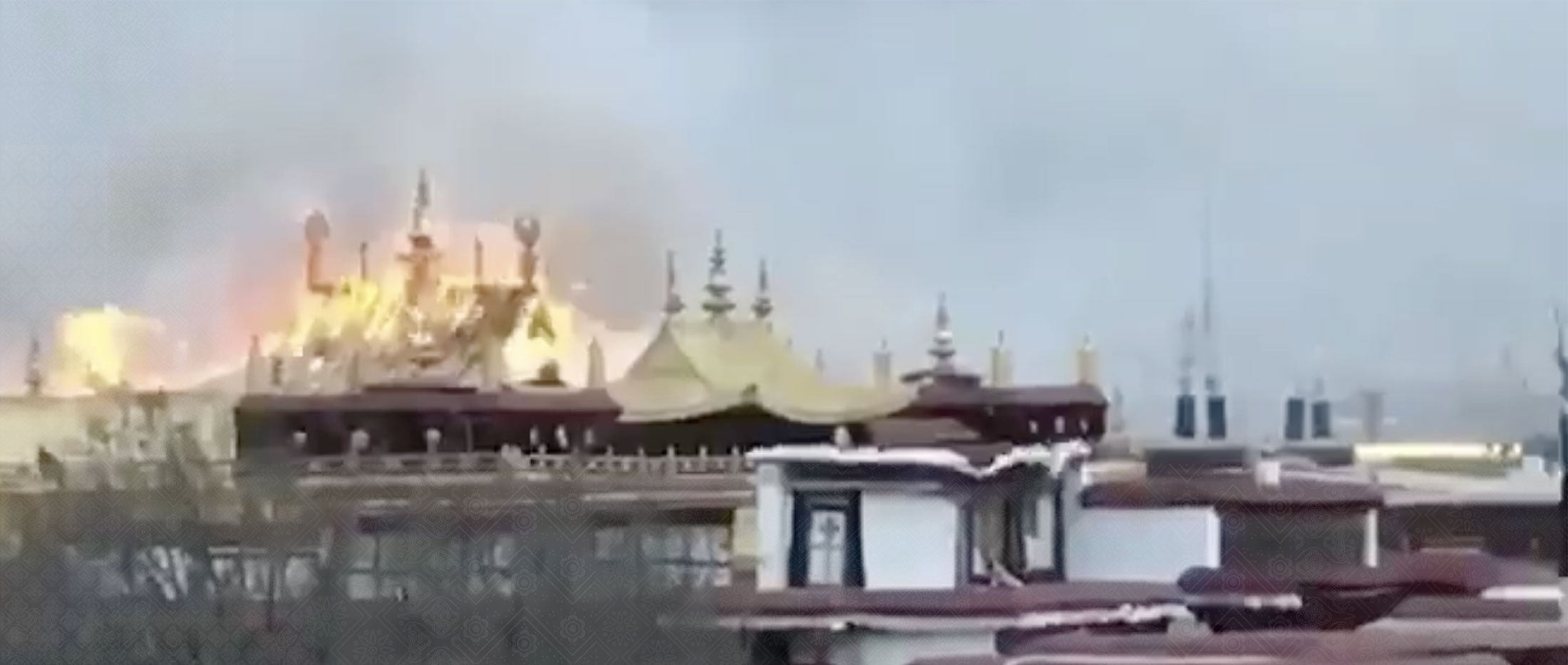
EXECUTIVE SUMMARY
Lhasa’s unique and precious remaining cultural heritage, due to be discussed at the upcoming UNESCO meeting in Bahrain (opening June 24), is imperiled as China fails to uphold its responsibilities provided by the World Heritage Convention and UNESCO guidelines.
Since the iconic Potala Palace and other significant buildings were recognized as UNESCO World Heritage in 1994, 2000, and 2001, termed by UNESCO as the ‘Potala Palace Historic Ensemble’, dozens of historic buildings have been demolished in Tibet’s ancient capital and the cityscape transformed by rapid urbanisation and infrastructure construction in accordance with China’s strategic and economic objectives. Four months on from a major fire at the holy Jokhang Temple in the heart of the city, the Chinese government is still blocking access and information and may be covering up substantial damage with inappropriate repair work.
The UNESCO World Heritage Committee, at its upcoming session in Manama, Bahrain (June 24-July 4), is to vote on a draft decision which requests information about the state of conservation of the ‘Potala Palace Historic Ensemble’ and of its surroundings, the so- called “buffer zones”, “as soon as possible”.[1] The draft decision also requests more detailed reports about the damage at the Jokhang temple and seeks an invitation for a ‘Reactive Monitoring Mission’ to assess the damage and repair work at the temple.
Bhuchung Tsering, Vice President of the International Campaign for Tibet, said: “Lhasa – the name means ‘Place of the Gods’ – was the center of Tibetan Buddhism, a city of pilgrimage, a cosmopolitan locus of Tibetan civilization, language and culture. In a travesty of conservation, ancient buildings have been demolished and ‘reconstructed’ as fakes – characterized by China as ‘authentic replicas’ – and emblematic of the commercialization of Tibetan culture. The need for protection of Lhasa’s remaining heritage, particularly following the fire at the Jokhang Temple, is now urgent. The Tibetan people have a right to enjoyment and protection of their cultural heritage. The Chinese government is failing to uphold this right.”
“UNESCO must be vigilant in enforcing the World Heritage Convention and take serious measures for the protection of Lhasa’s remaining cultural heritage. As the United Nations body tasked with the protection of the world’s irreplaceable natural and cultural wonders, at the meeting in Bahrain the UNESCO World Heritage Committee must act in accordance with its mandate, and should seriously question the urban plans imposed by a government that has already destroyed many historic buildings. UNESCO should require the Chinese government to adopt an authentic conservation approach in order for the remaining fragments of old Lhasa to be preserved, based on a detailed plan to protect the historic Barkhor area and buildings in the ‘Potala Palace Historic Ensemble’.
“Importantly, the Committee and member states of the world’s leading heritage organisation should ensure urgent access for independent verification of the status of the unique and precious architecture of the Jokhang temple, and its statues and murals, with a view to ensuring that repair work is conducted under the supervision of accredited conservation experts.”
THIS INTERNATIONAL CAMPAIGN FOR TIBET REPORT DETAILS THE FOLLOWING
- The Chinese government claims that it is developing Lhasa as a “green and harmonious city”, but images and urban plans included with this report convey the scale of new development and destruction since the historic center gained World Heritage status from 1994 onwards. Chinese officials say that “maintaining social stability”, a political term meaning the repression of any form of dissent, is a precondition for Lhasa’s development.
- Images included with this report show the massive expansion and transformation of Lhasa, including infrastructure projects with roads intended to be wide enough to serve as runways for military planes in line with the Chinese government’s focus on security and militarization, dramatic expansion of the new town near Lhasa’s main railway station and high rise development in the lower Toelung valley area.
- Dozens of historic buildings were demolished in the 10 years before the Jokhang Temple was listed under UNESCO in 2000, many of them with UNESCO World Heritage status. The ancient circumambulation route known as the Lingkor, which takes pilgrims around a number of holy sites in Lhasa, has been disrupted by often impassable new roads and Chinese buildings.
- After a major fire at the Jokhang Temple, the sacred heart of Lhasa, in February, China continues to suppress information about the extent of the damage and block Tibetans from circulating news. Active engagement or promotion of heritage issues by Tibetans in Lhasa today can be dangerous, given the political climate of total surveillance and hyper-securitization, in which peaceful expression of views about Tibetan culture, identity or religion can be criminalized. No foreign journalists or heritage experts have been allowed to visit Lhasa to ascertain the situation although the Chinese authorities acknowledged to UNESCO, a month after the event, that damage to the Jokhang is extensive.
- In a response to UNESCO late last year on the ‘Potala Palace Historic Ensemble’ in Lhasa, the Chinese authorities did not mention the key issue of preservation of historic buildings. And in its submissions on Lhasa, the World Heritage Committee too does not outline specific recommendations to protect the historic Barkhor and its surroundings. Almost all of the historic buildings of old Lhasa, once the center of Tibetan Buddhism and with a pivotal role in Tibetan civilization, have been destroyed and replaced by fake ‘Tibetan’-style architecture, which is completely at odds with its UNESCO World Heritage responsibilities. Official Chinese planning documents obtained by the International Campaign for Tibet confirm that this is set to continue with the remaining historic buildings, which number around 50 as new construction continues at a staggering rate.
- The acute threat to the integrity of the UNESCO World Heritage ‘Potala Palace Historic Ensemble’ is linked to a dramatic increase in Chinese domestic tourism and a rapidly expanding infrastructure in which Lhasa is a center of a new network of roads, railways and airports with dual military and civilian use, reflecting the region’s strategic significance to the Chinese government. Official planning documents reveal that development and tourism in the interests of the ideological imperative of “harmonious socialism” are the key priorities, with conservation scarcely mentioned.
EXECUTIVE SUMMARY
Lhasa’s unique and precious remaining cultural heritage, due to be discussed at the upcoming UNESCO meeting in Bahrain (opening June 24), is imperiled as China fails to uphold its responsibilities provided by the World Heritage Convention and UNESCO guidelines.
Since the iconic Potala Palace and other significant buildings were recognized as UNESCO World Heritage in 1994, 2000, and 2001, termed by UNESCO as the ‘Potala Palace Historic Ensemble’, dozens of historic buildings have been demolished in Tibet’s ancient capital and the cityscape transformed by rapid urbanisation and infrastructure construction in accordance with China’s strategic and economic objectives. Four months on from a major fire at the holy Jokhang Temple in the heart of the city, the Chinese government is still blocking access and information and may be covering up substantial damage with inappropriate repair work.
The UNESCO World Heritage Committee, at its upcoming session in Manama, Bahrain (June 24-July 4), is to vote on a draft decision which requests information about the state of conservation of the ‘Potala Palace Historic Ensemble’ and of its surroundings, the so- called “buffer zones”, “as soon as possible”.[1] The draft decision also requests more detailed reports about the damage at the Jokhang temple and seeks an invitation for a ‘Reactive Monitoring Mission’ to assess the damage and repair work at the temple.
Bhuchung Tsering, Vice President of the International Campaign for Tibet, said: “Lhasa – the name means ‘Place of the Gods’ – was the center of Tibetan Buddhism, a city of pilgrimage, a cosmopolitan locus of Tibetan civilization, language and culture. In a travesty of conservation, ancient buildings have been demolished and ‘reconstructed’ as fakes – characterized by China as ‘authentic replicas’ – and emblematic of the commercialization of Tibetan culture. The need for protection of Lhasa’s remaining heritage, particularly following the fire at the Jokhang Temple, is now urgent. The Tibetan people have a right to enjoyment and protection of their cultural heritage. The Chinese government is failing to uphold this right.”
“UNESCO must be vigilant in enforcing the World Heritage Convention and take serious measures for the protection of Lhasa’s remaining cultural heritage. As the United Nations body tasked with the protection of the world’s irreplaceable natural and cultural wonders, at the meeting in Bahrain the UNESCO World Heritage Committee must act in accordance with its mandate, and should seriously question the urban plans imposed by a government that has already destroyed many historic buildings. UNESCO should require the Chinese government to adopt an authentic conservation approach in order for the remaining fragments of old Lhasa to be preserved, based on a detailed plan to protect the historic Barkhor area and buildings in the ‘Potala Palace Historic Ensemble’.
“Importantly, the Committee and member states of the world’s leading heritage organisation should ensure urgent access for independent verification of the status of the unique and precious architecture of the Jokhang temple, and its statues and murals, with a view to ensuring that repair work is conducted under the supervision of accredited conservation experts.”
THIS INTERNATIONAL CAMPAIGN FOR TIBET REPORT DETAILS THE FOLLOWING
- The Chinese government claims that it is developing Lhasa as a “green and harmonious city”, but images and urban plans included with this report convey the scale of new development and destruction since the historic center gained World Heritage status from 1994 onwards. Chinese officials say that “maintaining social stability”, a political term meaning the repression of any form of dissent, is a precondition for Lhasa’s development.
- Images included with this report show the massive expansion and transformation of Lhasa, including infrastructure projects with roads intended to be wide enough to serve as runways for military planes in line with the Chinese government’s focus on security and militarization, dramatic expansion of the new town near Lhasa’s main railway station and high rise development in the lower Toelung valley area.
- Dozens of historic buildings were demolished in the 10 years before the Jokhang Temple was listed under UNESCO in 2000, many of them with UNESCO World Heritage status. The ancient circumambulation route known as the Lingkor, which takes pilgrims around a number of holy sites in Lhasa, has been disrupted by often impassable new roads and Chinese buildings.
- After a major fire at the Jokhang Temple, the sacred heart of Lhasa, in February, China continues to suppress information about the extent of the damage and block Tibetans from circulating news. Active engagement or promotion of heritage issues by Tibetans in Lhasa today can be dangerous, given the political climate of total surveillance and hyper-securitization, in which peaceful expression of views about Tibetan culture, identity or religion can be criminalized. No foreign journalists or heritage experts have been allowed to visit Lhasa to ascertain the situation although the Chinese authorities acknowledged to UNESCO, a month after the event, that damage to the Jokhang is extensive.
- In a response to UNESCO late last year on the ‘Potala Palace Historic Ensemble’ in Lhasa, the Chinese authorities did not mention the key issue of preservation of historic buildings. And in its submissions on Lhasa, the World Heritage Committee too does not outline specific recommendations to protect the historic Barkhor and its surroundings. Almost all of the historic buildings of old Lhasa, once the center of Tibetan Buddhism and with a pivotal role in Tibetan civilization, have been destroyed and replaced by fake ‘Tibetan’-style architecture, which is completely at odds with its UNESCO World Heritage responsibilities. Official Chinese planning documents obtained by the International Campaign for Tibet confirm that this is set to continue with the remaining historic buildings, which number around 50 as new construction continues at a staggering rate.
- The acute threat to the integrity of the UNESCO World Heritage ‘Potala Palace Historic Ensemble’ is linked to a dramatic increase in Chinese domestic tourism and a rapidly expanding infrastructure in which Lhasa is a center of a new network of roads, railways and airports with dual military and civilian use, reflecting the region’s strategic significance to the Chinese government. Official planning documents reveal that development and tourism in the interests of the ideological imperative of “harmonious socialism” are the key priorities, with conservation scarcely mentioned.
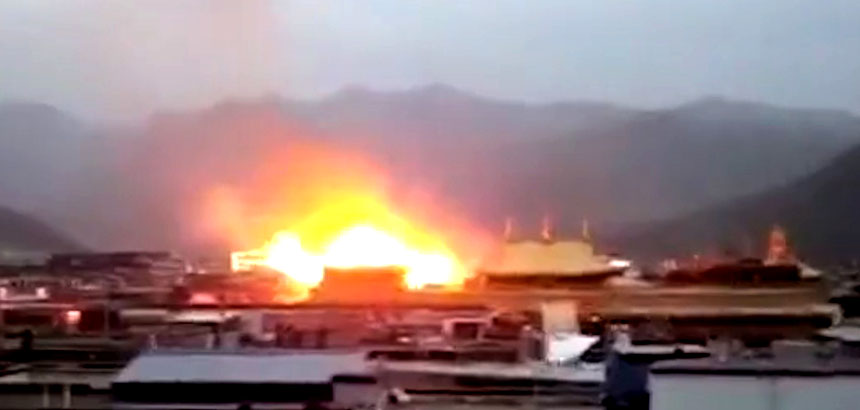
This image of the blaze at the holy Jokhang Temple on February 17, 2018, was captured on social media and circulated online before Tibetans were warned not to send news of the fire outside Tibet.

This image of the blaze at the holy Jokhang Temple on February 17, 2018, was captured on social media and circulated online before Tibetans were warned not to send news of the fire outside Tibet.
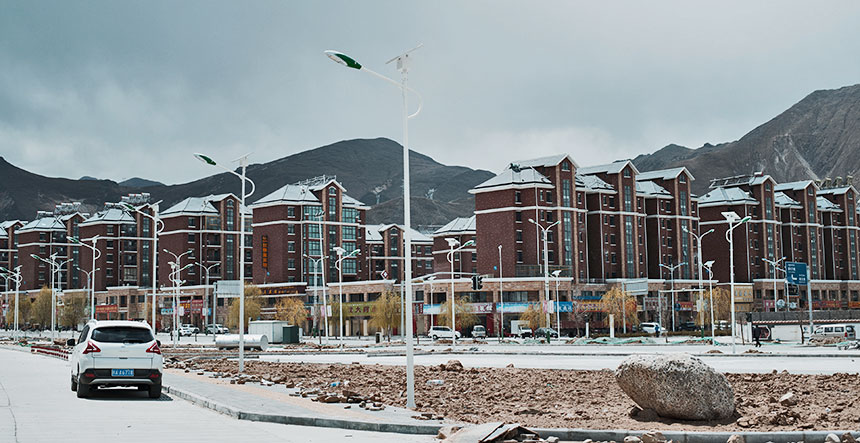
Newly built apartments in the west of Lhasa.

Newly built apartments in the west of Lhasa.
THE “POTALA PALACE HISTORIC ENSEMBLE”
These developments highlight the importance of an evaluation of the status of conservation in Tibet’s historic and cultural capital, Lhasa, raising urgent questions for the 42nd session of the World Heritage Committee that opens in Bahrain on June 24. The UNESCO World Heritage Committee is due to evaluate an updated report on the state of conservation of the Potala Palace, Norbulingka and Jokhang sites from the Chinese government when in Bahrain.[2] As part of this evaluation, the surroundings of the sites, the “buffer zones”, enjoy protection as well. A “buffer zone” serves to provide an additional layer of protection to a World Heritage property.[3] According to UNESCO’s Operational Guidelines, “[a]lthough buffer zones are not part of the nominated property, any modifications to or creation of buffer zones subsequent to inscription of a property on the World Heritage List should be approved by the World Heritage Committee.”[4]
The Historic Ensemble under question consists of three sites in the Lhasa valley: the Potala Palace, winter home of the Dalai Lama since the 17th century until the current Dalai Lama’s escape into exile in 1959, the Jokhang Temple, and the Norbulingka, the Dalai Lama’s traditional summer palace, including its surroundings.[5]
The three buildings were inscribed as UNESCO World Heritage in 1994, 2000, and 2001 respectively, and are described on the UNESCO World Heritage Committee website as follows: “The Potala Palace, winter palace of the Dalai Lama since the 17th century, symbolizes Tibetan Buddhism and its central role in the traditional administration of Tibet. The complex, comprising the White and Red Palaces with their ancillary buildings, is built on Red Mountain in the center of Lhasa Valley, at an altitude of 3,700m. Also founded in the 7th century, the Jokhang Temple Monastery is an exceptional Buddhist religious complex. Norbulingka, the Dalai Lama’s former summer palace, constructed in the 18th century, is a masterpiece of Tibetan art. The beauty and originality of the architecture of these three sites, their rich ornamentation and harmonious integration in a striking landscape, add to their historic and religious interest.”[6]
THE “POTALA PALACE HISTORIC ENSEMBLE”
These developments highlight the importance of an evaluation of the status of conservation in Tibet’s historic and cultural capital, Lhasa, raising urgent questions for the 42nd session of the World Heritage Committee that opens in Bahrain on June 24. The UNESCO World Heritage Committee is due to evaluate an updated report on the state of conservation of the Potala Palace, Norbulingka and Jokhang sites from the Chinese government when in Bahrain.[2] As part of this evaluation, the surroundings of the sites, the “buffer zones”, enjoy protection as well. A “buffer zone” serves to provide an additional layer of protection to a World Heritage property.[3] According to UNESCO’s Operational Guidelines, “[a]lthough buffer zones are not part of the nominated property, any modifications to or creation of buffer zones subsequent to inscription of a property on the World Heritage List should be approved by the World Heritage Committee.”[4]
The Historic Ensemble under question consists of three sites in the Lhasa valley: the Potala Palace, winter home of the Dalai Lama since the 17th century until the current Dalai Lama’s escape into exile in 1959, the Jokhang Temple, and the Norbulingka, the Dalai Lama’s traditional summer palace, including its surroundings.[5]
The three buildings were inscribed as UNESCO World Heritage in 1994, 2000, and 2001 respectively, and are described on the UNESCO World Heritage Committee website as follows: “The Potala Palace, winter palace of the Dalai Lama since the 17th century, symbolizes Tibetan Buddhism and its central role in the traditional administration of Tibet. The complex, comprising the White and Red Palaces with their ancillary buildings, is built on Red Mountain in the center of Lhasa Valley, at an altitude of 3,700m. Also founded in the 7th century, the Jokhang Temple Monastery is an exceptional Buddhist religious complex. Norbulingka, the Dalai Lama’s former summer palace, constructed in the 18th century, is a masterpiece of Tibetan art. The beauty and originality of the architecture of these three sites, their rich ornamentation and harmonious integration in a striking landscape, add to their historic and religious interest.”[6]
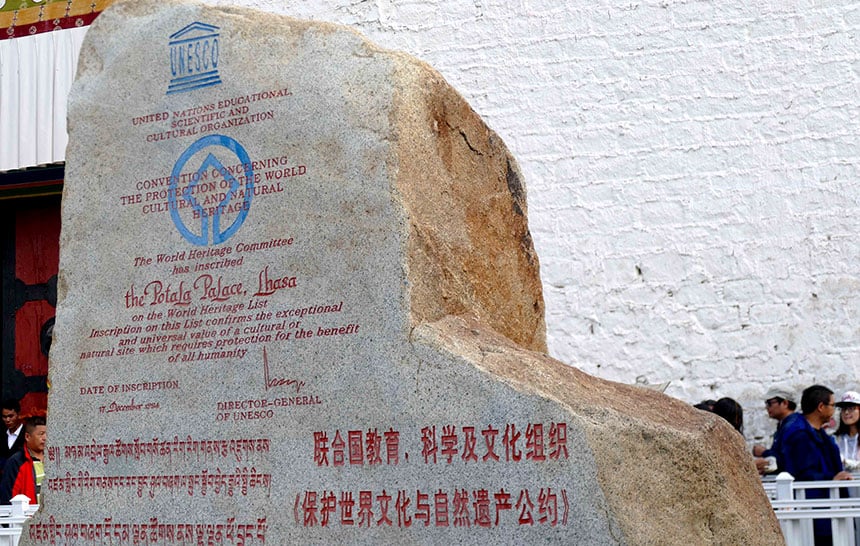
Commemorative stone marking the recognition of the Potala Palace as UNESCO World Heritage in Lhasa.

Commemorative stone marking the recognition of the Potala Palace as UNESCO World Heritage in Lhasa.
The importance of these buildings and the surrounding area to the Tibetan people or to the world cannot be overstated. The late Andre Alexander, leading scholar on Tibetan heritage and founder of the Tibet Heritage Fund,[7] wrote: “The Tibetan capital of Lhasa is more than just a city of timber and stone, glass and steel. For centuries, Lhasa’s prestige and influence as both cradle and center of Tibetan Buddhism gave it a pivotal role within Tibetan civilization.”[8] Alexander wrote about the Jokhang that it is a “miraculously-preserved physical testimony to the history of Buddhism […] The Tibetans have since long associated the Jokhang with the genesis of their cultural and religious civilization. But its importance goes even beyond that, touching the cultural histories of India, China and beyond.”[9]
It is a measure of what the Jokhang Temple means to Tibetans that after the fire on February 17 (2018), in freezing temperatures, some Tibetan pilgrims began to sleep on the ground outside the temple, demonstrating the level of distress and concern about the fate of this most sacred site, while others carried out prostrations from 4am every day.[10]
The importance of these buildings and the surrounding area to the Tibetan people or to the world cannot be overstated. The late Andre Alexander, leading scholar on Tibetan heritage and founder of the Tibet Heritage Fund,[7] wrote: “The Tibetan capital of Lhasa is more than just a city of timber and stone, glass and steel. For centuries, Lhasa’s prestige and influence as both cradle and center of Tibetan Buddhism gave it a pivotal role within Tibetan civilization.”[8] Alexander wrote about the Jokhang that it is a “miraculously-preserved physical testimony to the history of Buddhism […] The Tibetans have since long associated the Jokhang with the genesis of their cultural and religious civilization. But its importance goes even beyond that, touching the cultural histories of India, China and beyond.”[9]
It is a measure of what the Jokhang Temple means to Tibetans that after the fire on February 17 (2018), in freezing temperatures, some Tibetan pilgrims began to sleep on the ground outside the temple, demonstrating the level of distress and concern about the fate of this most sacred site, while others carried out prostrations from 4am every day.[10]
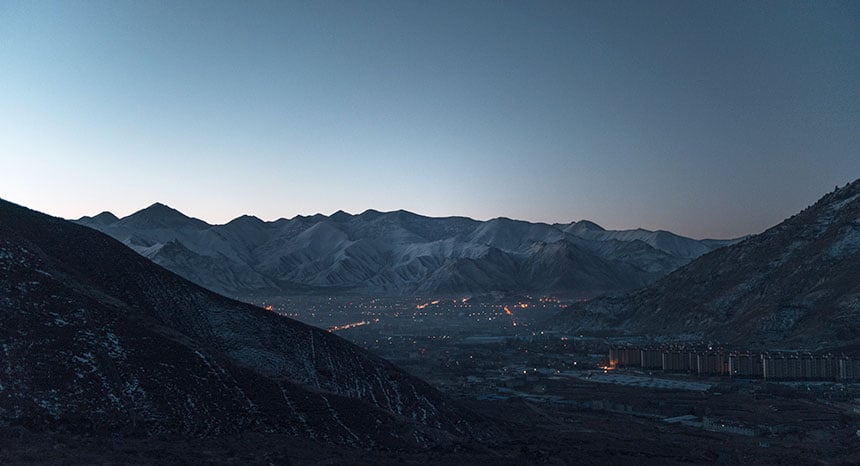
Cityscape at night, showing new developments in the foreground.

Cityscape at night, showing new developments in the foreground.
DESTRUCTION AND DEVELOPMENT IN LHASA
DESTRUCTION AND DEVELOPMENT IN LHASA
“We Tibetans love our culture, and that includes our architecture. Our homes keep us cool in the summer and warm in the winter. But now, they’re disappearing. One by one, our traditional houses seem to vanish overnight, and in their place we are given cold, concrete boxes, which we’re told are much better for us. Why? Why?”
– Unnamed Tibetan in Lhasa[11]
“We Tibetans love our culture, and that includes our architecture. Our homes keep us cool in the summer and warm in the winter. But now, they’re disappearing. One by one, our traditional houses seem to vanish overnight, and in their place we are given cold, concrete boxes, which we’re told are much better for us. Why? Why?”
– Unnamed Tibetan in Lhasa[11]
The Chinese government has repeatedly failed to preserve historic Tibetan architecture in Lhasa, despite the relatively small size of the city’s ancient core. According to the earliest existing proper survey of the city, Lhasa in 1948 consisted of around 700 traditional Tibetan town houses, a small city by any standards.[12] Today, there are around 50 left.[13]
According to documentation by Tibet Heritage Fund – which was forced to leave Lhasa in 2000 – by 1993, little more than 300 of historic Tibetan buildings remained.[14] Under the ‘Lhasa Development Plan 1980-2000’ and the ‘Barkhor Conservation Plan 1992’, most of Old Lhasa’s historic-traditional buildings were demolished and replaced with three to four story ‘neo-Tibetan’ cement houses. Many of these buildings were replaced after the Potala Palace Ensemble was nominated for UNESCO World Heritage status and the historic old town had been approved by the Chinese authorities as a ”National Historically and Culturally Famous City” with listed historic buildings in the vicinity of the Jokhang Temple designated as “Priority Protected Sites”.[15]
Notably, in 1994 efforts by the head of the UNESCO delegation, Minja Yang, to mobilise the international community against the Chinese government’s destruction of historical buildings failed.[16] Just after the nomination of the Potala Palace for UNESCO status, in early 1995, two-thirds of the historic buildings comprising the historic Tibetan government district of Shol at the foot of the Palace were demolished. By January 2010, the number of historic Tibetan buildings in Lhasa had dwindled down to less than 100, and there are now around 50.[17]
The Chinese government has repeatedly failed to preserve historic Tibetan architecture in Lhasa, despite the relatively small size of the city’s ancient core. According to the earliest existing proper survey of the city, Lhasa in 1948 consisted of around 700 traditional Tibetan town houses, a small city by any standards.[12] Today, there are around 50 left.[13]
According to documentation by Tibet Heritage Fund – which was forced to leave Lhasa in 2000 – by 1993, little more than 300 of historic Tibetan buildings remained.[14] Under the ‘Lhasa Development Plan 1980-2000’ and the ‘Barkhor Conservation Plan 1992’, most of Old Lhasa’s historic-traditional buildings were demolished and replaced with three to four story ‘neo-Tibetan’ cement houses. Many of these buildings were replaced after the Potala Palace Ensemble was nominated for UNESCO World Heritage status and the historic old town had been approved by the Chinese authorities as a ”National Historically and Culturally Famous City” with listed historic buildings in the vicinity of the Jokhang Temple designated as “Priority Protected Sites”.[15]
Notably, in 1994 efforts by the head of the UNESCO delegation, Minja Yang, to mobilise the international community against the Chinese government’s destruction of historical buildings failed.[16] Just after the nomination of the Potala Palace for UNESCO status, in early 1995, two-thirds of the historic buildings comprising the historic Tibetan government district of Shol at the foot of the Palace were demolished. By January 2010, the number of historic Tibetan buildings in Lhasa had dwindled down to less than 100, and there are now around 50.[17]
ALARMING IMPLICATIONS OF CHINA’S URBAN PLANS
Despite the unique importance of Lhasa’s cultural heritage and its remaining historic buildings, a Chinese state response to UNESCO, issued in November 2017,[18] does not refer to the fundamental issue of the preservation of the remaining historic buildings on the Barkhor or the buffer zones. And in its prior submission to the Chinese state party, UNESCO does not outline its recommendations for their protection.[19]
In the document submitted to the Chinese state party by UNESCO after the World Heritage Committee meeting in Istanbul in 2016, UNESCO even noted “with satisfaction” China’s compliance in mitigating the impact of a large shopping mall partially by “renovation of the façade in traditional Tibetan architectural style” – effectively an endorsement of China’s approach to create replicas of Tibetan historical buildings rather than preserving the actual buildings.[20]
The priorities detailed for Lhasa in official Chinese documents obtained by the International Campaign for Tibet have alarming implications for the survival of Lhasa’s remaining heritage, and adopt a different tone to those submitted to UNESCO for discussion in Bahrain at the World Heritage Committee.
China’s Master Urban Plan for Lhasa is a central element of Lhasa’s urbanization as well as a tool for territorial control and blueprint for development of the city. In the urban plan revised in 2008 and obtained by the International Campaign for Tibet, development and tourism are outlined as the key priorities in Lhasa, with conservation scarcely mentioned. The main objective outlined in the plan is ideological rather than heritage-oriented, stating the intention of the creation of “a new Lhasa [to be] built under harmonious and prosperous socialism.”[21]
Tibetan official Che Dalha (Chinese: Qi Zhala), one of the leading figures involved in Lhasa’s rapid urbanisation, has made it clear that the task of “maintaining social stability […] is the precondition and guarantee for the development of Lhasa”. Maintenance of stability is political language referring to the crushing of any dissent and ensuring allegiance to the CCP authorities in order for the authorities to pursue their strategic and economic objectives on the plateau without impediment.[22]
Images included with this report show the massive expansion and transformation of Lhasa, including infrastructure projects with roads intended to be wide enough to serve as runways for military planes in line with the Chinese government’s focus on security and militarization,[23] dramatic expansion of the new town near Lhasa’s main railway station and high rise development in the lower Toelung valley area.
In the section of the urban plan about renovation of the city for tourism, there is no mention of preservation of historic buildings, even in the section about the old town of Lhasa.[24] Chapter Nine of the Urban Plan raises the “preservation of history and culture” but only in broad and general terms.
In the same document, the Historic Ensemble area is designated as one of the main areas for “improvement” in the “short-term construction plan”, raising concerns over possible demolitions to create more tourist infrastructure.
Under the urban plan, Lhasa has not only undergone demolition of its ancient heritage, but also its not so old buildings. Emily Yeh, a scholar who has charted Lhasa’s development, writes: “The demolition of recently built single-family houses in favor of uniform row houses and apartment blocks conjures the appearance of development, producing a developed urban landscape through a process of ‘creative destruction’ that fuels capital accumulation for coalitions of real estate development companies and local governments.”[25]
A further document issued by the State Council on Lhasa city planning last year (2017) is more specific on plans to demolish old buildings, stating that the authorities will: “Speed up reconstruction of dilapidated housing and of support infrastructure in shantytowns, city-centre villages and in urban and rural areas.”[26]
In an indication of ongoing construction and demolition plans in the ancient heart of Lhasa, of which little original architectural fabric remains, construction companies were invited to tender by April (2018) for implementation of an “old city transformation strategic planning project” approved by the Party Group of the Urban and Rural Planning Bureau of Lhasa.[27]
In one of its only references to protecting culture of the city, a Chinese State Council document on Lhasa’s urban planning states not that buildings must be preserved, but that the Chinese authorities must “protect the traditional style and configuration of the city, particularly in the historical urban districts”. This is a direct reference to new buildings that have been constructed in Tibetan style.[28]
“Very often the understanding of ‘conservation’ in Asia is the replacement of historic structures by new buildings, with little or no resemblance to the old ones regarding design, building techniques or materials,” wrote Pimpim de Azevedo and the late Andre Alexander of the Tibet Heritage Fund.[29] “This causes substantial loss of historic buildings.” Azevedo and Alexander cited for example the 7th century Barkhor street in Lhasa, both a pilgrimage route and important market street, has been redesigned to “fit some kitsch view of Tibet that may appeal to national and international tourists. For example, streetlights resembling prayer wheels have been installed, and the street sellers removed elsewhere. Another example of this kind of attitude [in Lhasa] is the decorative red frieze usually used only in palaces and temples. In recent years, this type of frieze was applied without discrimination to any building, including hotels, public toilets, etc.”[30]
ALARMING IMPLICATIONS OF CHINA’S URBAN PLANS
Despite the unique importance of Lhasa’s cultural heritage and its remaining historic buildings, a Chinese state response to UNESCO, issued in November 2017,[18] does not refer to the fundamental issue of the preservation of the remaining historic buildings on the Barkhor or the buffer zones. And in its prior submission to the Chinese state party, UNESCO does not outline its recommendations for their protection.[19]
In the document submitted to the Chinese state party by UNESCO after the World Heritage Committee meeting in Istanbul in 2016, UNESCO even noted “with satisfaction” China’s compliance in mitigating the impact of a large shopping mall partially by “renovation of the façade in traditional Tibetan architectural style” – effectively an endorsement of China’s approach to create replicas of Tibetan historical buildings rather than preserving the actual buildings.[20]
The priorities detailed for Lhasa in official Chinese documents obtained by the International Campaign for Tibet have alarming implications for the survival of Lhasa’s remaining heritage, and adopt a different tone to those submitted to UNESCO for discussion in Bahrain at the World Heritage Committee.
China’s Master Urban Plan for Lhasa is a central element of Lhasa’s urbanization as well as a tool for territorial control and blueprint for development of the city. In the urban plan revised in 2008 and obtained by the International Campaign for Tibet, development and tourism are outlined as the key priorities in Lhasa, with conservation scarcely mentioned. The main objective outlined in the plan is ideological rather than heritage-oriented, stating the intention of the creation of “a new Lhasa [to be] built under harmonious and prosperous socialism.”[21]
Tibetan official Che Dalha (Chinese: Qi Zhala), one of the leading figures involved in Lhasa’s rapid urbanisation, has made it clear that the task of “maintaining social stability […] is the precondition and guarantee for the development of Lhasa”. Maintenance of stability is political language referring to the crushing of any dissent and ensuring allegiance to the CCP authorities in order for the authorities to pursue their strategic and economic objectives on the plateau without impediment.[22]
Images included with this report show the massive expansion and transformation of Lhasa, including infrastructure projects with roads intended to be wide enough to serve as runways for military planes in line with the Chinese government’s focus on security and militarization,[23] dramatic expansion of the new town near Lhasa’s main railway station and high rise development in the lower Toelung valley area.
In the section of the urban plan about renovation of the city for tourism, there is no mention of preservation of historic buildings, even in the section about the old town of Lhasa.[24] Chapter Nine of the Urban Plan raises the “preservation of history and culture” but only in broad and general terms.
In the same document, the Historic Ensemble area is designated as one of the main areas for “improvement” in the “short-term construction plan”, raising concerns over possible demolitions to create more tourist infrastructure.
Under the urban plan, Lhasa has not only undergone demolition of its ancient heritage, but also its not so old buildings. Emily Yeh, a scholar who has charted Lhasa’s development, writes: “The demolition of recently built single-family houses in favor of uniform row houses and apartment blocks conjures the appearance of development, producing a developed urban landscape through a process of ‘creative destruction’ that fuels capital accumulation for coalitions of real estate development companies and local governments.”[25]
A further document issued by the State Council on Lhasa city planning last year (2017) is more specific on plans to demolish old buildings, stating that the authorities will: “Speed up reconstruction of dilapidated housing and of support infrastructure in shantytowns, city-centre villages and in urban and rural areas.”[26]
In an indication of ongoing construction and demolition plans in the ancient heart of Lhasa, of which little original architectural fabric remains, construction companies were invited to tender by April (2018) for implementation of an “old city transformation strategic planning project” approved by the Party Group of the Urban and Rural Planning Bureau of Lhasa.[27]
In one of its only references to protecting culture of the city, a Chinese State Council document on Lhasa’s urban planning states not that buildings must be preserved, but that the Chinese authorities must “protect the traditional style and configuration of the city, particularly in the historical urban districts”. This is a direct reference to new buildings that have been constructed in Tibetan style.[28]
“Very often the understanding of ‘conservation’ in Asia is the replacement of historic structures by new buildings, with little or no resemblance to the old ones regarding design, building techniques or materials,” wrote Pimpim de Azevedo and the late Andre Alexander of the Tibet Heritage Fund.[29] “This causes substantial loss of historic buildings.” Azevedo and Alexander cited for example the 7th century Barkhor street in Lhasa, both a pilgrimage route and important market street, has been redesigned to “fit some kitsch view of Tibet that may appeal to national and international tourists. For example, streetlights resembling prayer wheels have been installed, and the street sellers removed elsewhere. Another example of this kind of attitude [in Lhasa] is the decorative red frieze usually used only in palaces and temples. In recent years, this type of frieze was applied without discrimination to any building, including hotels, public toilets, etc.”[30]
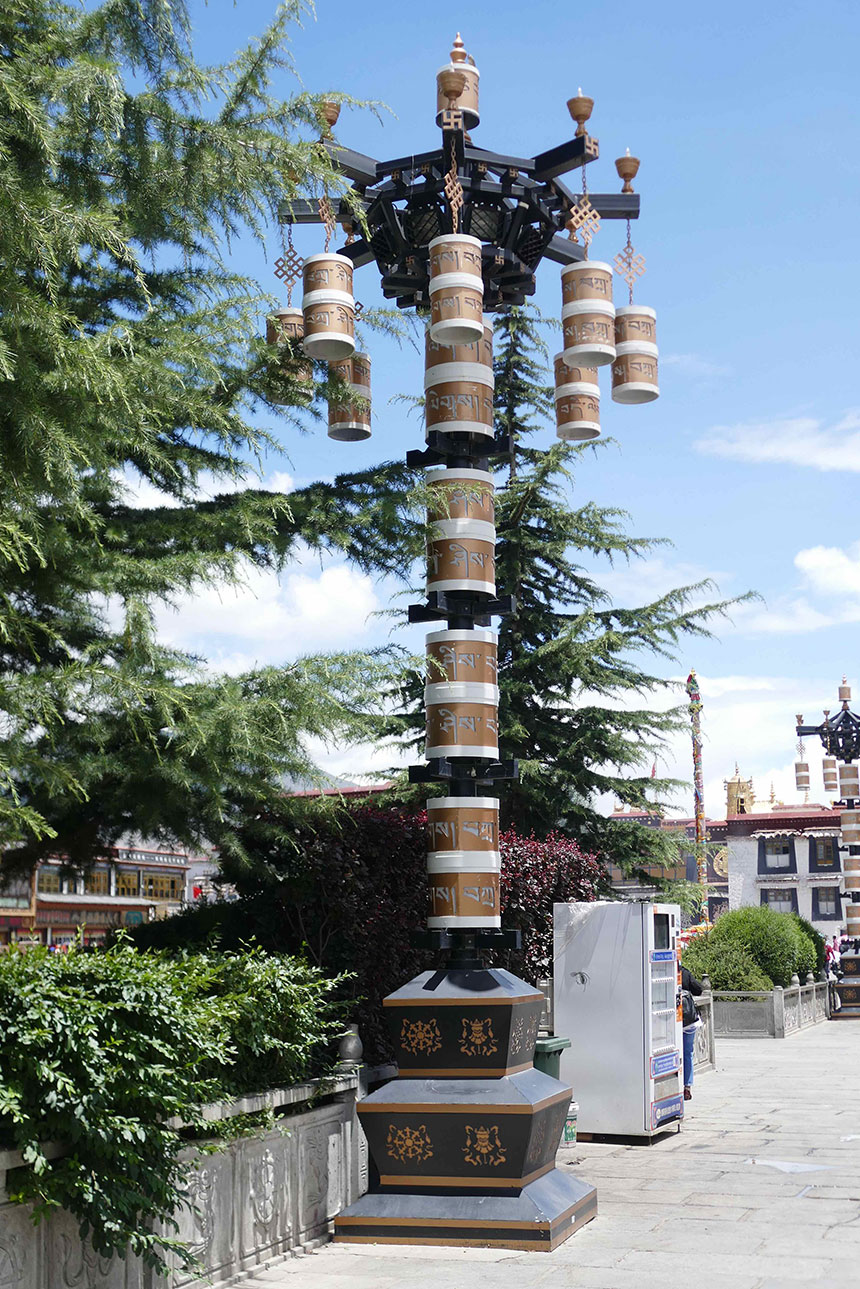
This image, which was taken before the Jokhang fire in February, shows the ‘Tibetan-style’ streetlights outside the temple.

This image, which was taken before the Jokhang fire in February, shows the ‘Tibetan-style’ streetlights outside the temple.
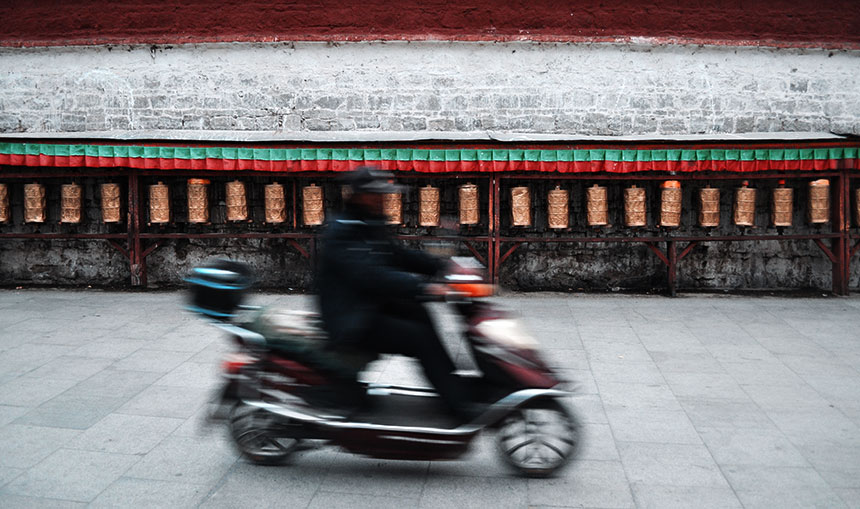
A Tibetan motorcyclist rides around the Potala Palace.

A Tibetan motorcyclist rides around the Potala Palace.

Two Tibetan elderly women doing a pilgrimage on the Lingkor; now Tibetans have to traverse busy roads and cross bridges to follow the holy circuit.

Two Tibetan elderly women doing a pilgrimage on the Lingkor; now Tibetans have to traverse busy roads and cross bridges to follow the holy circuit.
PILGRIMAGE TO THE ‘PLACE OF THE GODS’
Lhasa, its literal meaning being ‘Place of the Gods’, has always had a deep spiritual significance, and it is the wish of Tibetans across Tibet to go on pilgrimage there. Andre Alexander wrote that the city “was seen as an embodiment of one of the primary symbols of Buddhism, the Dharmachakra,[31] situated in a blessed landscape full of auspicious signs. In relation to Tibet, Lhasa and its temple were placed in the center, pressing down the heart of a personification of the old and uncivilized pre-Buddhist Tibet.”[32]
Today, the ancient circumambulation route of the Lingkor, which takes the pilgrim around all the holy sites in Lhasa, has been disrupted by new roads and Chinese buildings, creating a “strong sense of socio-spatial disorientation” for Tibetan pilgrims.[33]
While the UNESCO World Heritage Committee also urged China to “Include provisions in the Urban Master Plan to maintain the spatial linkages and visual corridors between the component parts of the property, their historical context and wider setting, and to promote and maintain the traditional urban structure and layout of the buffer zones. This should include, but should not be limited to, regulations regarding acceptable heights, visual qualities, façades and roofs”[34] – it did not mention the protection of existing historic buildings in terms of their architecture and authenticity.
PILGRIMAGE TO THE ‘PLACE OF THE GODS’
Lhasa, its literal meaning being ‘Place of the Gods’, has always had a deep spiritual significance, and it is the wish of Tibetans across Tibet to go on pilgrimage there. Andre Alexander wrote that the city “was seen as an embodiment of one of the primary symbols of Buddhism, the Dharmachakra,[31] situated in a blessed landscape full of auspicious signs. In relation to Tibet, Lhasa and its temple were placed in the center, pressing down the heart of a personification of the old and uncivilized pre-Buddhist Tibet.”[32]
Today, the ancient circumambulation route of the Lingkor, which takes the pilgrim around all the holy sites in Lhasa, has been disrupted by new roads and Chinese buildings, creating a “strong sense of socio-spatial disorientation” for Tibetan pilgrims.[33]
While the UNESCO World Heritage Committee also urged China to “Include provisions in the Urban Master Plan to maintain the spatial linkages and visual corridors between the component parts of the property, their historical context and wider setting, and to promote and maintain the traditional urban structure and layout of the buffer zones. This should include, but should not be limited to, regulations regarding acceptable heights, visual qualities, façades and roofs”[34] – it did not mention the protection of existing historic buildings in terms of their architecture and authenticity.
THE JOKHANG FIRE AND LHASA’S CULTURAL HERITAGE
THE JOKHANG FIRE AND LHASA’S CULTURAL HERITAGE
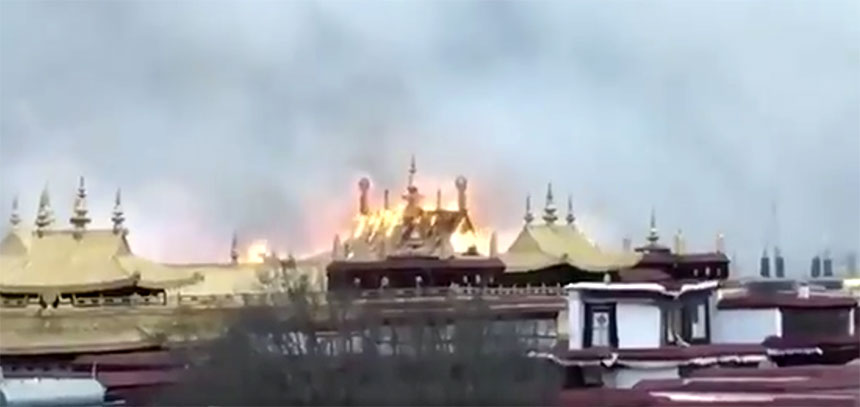
This image of the blaze at the holy Jokhang Temple on February 17, 2018, was captured on social media and circulated online before Tibetans were warned not to send news of the fire outside of Tibet.

This image of the blaze at the holy Jokhang Temple on February 17, 2018, was captured on social media and circulated online before Tibetans were warned not to send news of the fire outside of Tibet.
On the second day of Tibetan New Year, February 17 (2018), a fire broke out in the most sacred temple of Tibet, the Jokhang in Lhasa, Tibet’s historic and cultural capital. Videos emerged showing flames shooting from the golden roof of the temple, a place of unparalleled religious importance not only to Tibetans but also to Buddhists across the globe. In the background, the sound of Tibetans weeping in distress and praying could be heard. And then, silence. China’s Party state suppressed any news about the fire and rebuffed attempts by international experts to ascertain the damage, even though the Jokhang is a UNESCO World Heritage site. In a telling admission, Tibetans posted emojis of faces with gagged mouths.
In a stark demonstration of China’s strategies to isolate and lock down Tibet, the full extent of fire damage to Tibet’s cultural and historic heart is still unknown, and there are concerns that inappropriate repair work may be undertaken on its historic structure in order to cover up the damage, according to Tibetan sources. Immediately following the fire, the International Campaign for Tibet received information indicating that damage was likely to be extensive, backed up by assessment by experts of post-fire video footage and stills.[35]
China responded to the UNESCO World Heritage Center a month after the fire, on March 16, acknowledging damage to the Jokhang as follows: “A ventilation chamber on the 2nd floor of the Back Hall of the Main Hall caught fire and approximately 50m2 of the hall burned. Emergency measures were immediately put in place, and the Golden Ceiling of the back hall was carefully dismantled to ensure that it could not be damaged in the event that the fire had caused structural problems (which was later determined not to be the case). The Statue of Sakyamuni Buddha suffered no damage, but was given a temporary protective covering as a precautionary measure; the fire only had a minor impact on the first floor, and Jokhang Temple Monastery was therefore reopened to the public the following day; damage due to the fire included partial burn damage to the ventilation chamber and its golden ceiling and to some wooden columns and beams. The gilded bronze ceiling and other decorative elements remain intact, with several components suffering minor deformation or other burn damage. Some murals, baga [sic] soil walls, and aga [sic] soil floors from the 1980s also suffered damage.”[36]
It is not known whether the response can be taken at face value given the extent to which China has sought to cover up any damage so far. Concerns are compounded by the lack of access for architecture or heritage experts, given China’s tight grip over the region; the fire happened at a time when Lhasa and the rest of the Tibet Autonomous Region were closed to foreign visitors in what has become an annual lockdown due to the sensitive political anniversary of the 1959 March 10 Uprising and 2008 protests.[37]
Recognizing the incomplete nature of the information available on the fire’s aftermath, a draft decision has been put forward for decision of the World Heritage Committee in Bahrain, stating: “Expresses its regret at the fire of February 2018, and notes the work carried out by the State Party in the immediate aftermath of the fire; […] Requests the State Party to provide to the World Heritage Centre, for review by the Advisory Bodies, more detailed reports of all the damage caused by the aforementioned fire, including images, drawings and other graphic illustrations and paying particular attention to the Golden Ceiling, as more detailed damage assessments are being carried out and restoration plans developed”.[38]
The Chinese government is also requested to invite a joint “Reactive Monitoring” mission of the World Heritage Centre, the International Council on Monuments and Sites (ICOMOS) and the International Centre for the Study of the Preservation and Restoration of Cultural Property (ICCROM) to the Jokhang, to “assess the damage caused by the fire and the proposed restoration works to be undertaken, as well as to examine other aspects of the state of conservation of the property”.
On the second day of Tibetan New Year, February 17 (2018), a fire broke out in the most sacred temple of Tibet, the Jokhang in Lhasa, Tibet’s historic and cultural capital. Videos emerged showing flames shooting from the golden roof of the temple, a place of unparalleled religious importance not only to Tibetans but also to Buddhists across the globe. In the background, the sound of Tibetans weeping in distress and praying could be heard. And then, silence. China’s Party state suppressed any news about the fire and rebuffed attempts by international experts to ascertain the damage, even though the Jokhang is a UNESCO World Heritage site. In a telling admission, Tibetans posted emojis of faces with gagged mouths.
In a stark demonstration of China’s strategies to isolate and lock down Tibet, the full extent of fire damage to Tibet’s cultural and historic heart is still unknown, and there are concerns that inappropriate repair work may be undertaken on its historic structure in order to cover up the damage, according to Tibetan sources. Immediately following the fire, the International Campaign for Tibet received information indicating that damage was likely to be extensive, backed up by assessment by experts of post-fire video footage and stills.[35]
China responded to the UNESCO World Heritage Center a month after the fire, on March 16, acknowledging damage to the Jokhang as follows: “A ventilation chamber on the 2nd floor of the Back Hall of the Main Hall caught fire and approximately 50m2 of the hall burned. Emergency measures were immediately put in place, and the Golden Ceiling of the back hall was carefully dismantled to ensure that it could not be damaged in the event that the fire had caused structural problems (which was later determined not to be the case). The Statue of Sakyamuni Buddha suffered no damage, but was given a temporary protective covering as a precautionary measure; the fire only had a minor impact on the first floor, and Jokhang Temple Monastery was therefore reopened to the public the following day; damage due to the fire included partial burn damage to the ventilation chamber and its golden ceiling and to some wooden columns and beams. The gilded bronze ceiling and other decorative elements remain intact, with several components suffering minor deformation or other burn damage. Some murals, baga [sic] soil walls, and aga [sic] soil floors from the 1980s also suffered damage.”[36]
It is not known whether the response can be taken at face value given the extent to which China has sought to cover up any damage so far. Concerns are compounded by the lack of access for architecture or heritage experts, given China’s tight grip over the region; the fire happened at a time when Lhasa and the rest of the Tibet Autonomous Region were closed to foreign visitors in what has become an annual lockdown due to the sensitive political anniversary of the 1959 March 10 Uprising and 2008 protests.[37]
Recognizing the incomplete nature of the information available on the fire’s aftermath, a draft decision has been put forward for decision of the World Heritage Committee in Bahrain, stating: “Expresses its regret at the fire of February 2018, and notes the work carried out by the State Party in the immediate aftermath of the fire; […] Requests the State Party to provide to the World Heritage Centre, for review by the Advisory Bodies, more detailed reports of all the damage caused by the aforementioned fire, including images, drawings and other graphic illustrations and paying particular attention to the Golden Ceiling, as more detailed damage assessments are being carried out and restoration plans developed”.[38]
The Chinese government is also requested to invite a joint “Reactive Monitoring” mission of the World Heritage Centre, the International Council on Monuments and Sites (ICOMOS) and the International Centre for the Study of the Preservation and Restoration of Cultural Property (ICCROM) to the Jokhang, to “assess the damage caused by the fire and the proposed restoration works to be undertaken, as well as to examine other aspects of the state of conservation of the property”.
EXCLUSION OF TIBETANS AS SUPPORT FOR CULTURE IS DEEMED ‘REACTIONARY’
UNESCO also commends China on its efforts to “integrate traditional knowledge systems” encouraging the “formal integration” of this approach in “conservation and management arrangements for the property [the Historic Ensemble].”[39] But due to the political imperatives of the Chinese government, the space for Tibetans to be involved in decision-making on their heritage is virtually non-existent, with policy imposed from the top-down.[40]
The absence of Tibetans from the planning process is revealed by the details given in the official documents of the various central and regional government and Party departments involved in the planning process, from the first urban plan for Lhasa approved by the State Council on April 13, 1983. Throughout the process, spearheaded by the most senior leaders in the Tibet Autonomous Region, the Ministry of Construction was involved – but no local people, culture or heritage experts, are listed as being involved in the process of planning the development of Lhasa and protection of its heritage.
A response from the State Council on the overall planning as Lhasa makes the political imperatives of development of the city clear when it states: “City-level planning may not be delegated down, effectively ensuring the implementation of the plan”.[41]
In the Chinese State Council response on Lhasa’s planning, the ‘Tibetanness’ of Lhasa was even further downgraded in its description of the city as having merely “ethnic characteristics”, stating: “Lhasa is the capital of the Tibet Autonomous Region and a famous national historical and cultural city and an international tourist city with snow-covered plateau characteristics and ethnic characteristics.”[42]
This is a further indication of the current policy orientation, intensified following the important 19th Party Congress in Beijing last October, towards the elimination of protections of social and cultural differences among Tibetans and other “ethnic minorities” in the PRC, reversing earlier approaches recognizing “ethnic autonomy” and strengthening policies that undermine Tibetan language, culture and religion.[43]
An official circular distributed in Lhasa in February described the protection of Tibetan culture as a “reactionary and narrow nationalistic idea”.[44] The document, which urged the public to report on those suspected of being loyal to the “evil forces” of the Dalai Lama, referred to “22 illegal activities” effectively criminalizing those who speak about issues such as environmental protection and “folk culture” by labeling them as “‘spokespersons’ of the Dalai clique and hostile foreign [non-mainland] forces.”
In this political climate, Tibetans are likely to be fearful of being involved or speaking out about heritage issues, for instance in the aftermath of the Jokhang fire.
Overseas Tibetans with family or friends in Lhasa could usually be expected to find out more information about such incidents, but in this case they could not. Even as early as the evening of February 18, a day after the fire, a Tibetan from Lhasa who now lives in France explained that they “dare not ask for news”. Scholar and Tibetan literature specialist Francoise Robin wrote in an article about the fire’s aftermath: “Since then, that friend has only been able to learn that the monks at the Jokhang were confined to the temple on the Sunday after the fire, usually a day on which they visit their families. My friend deduced from this that Jokhang monks were prevented from going out in case they reveal to their relatives the extent of the damage.”[45] This atmosphere may explain why some early reports from Lhasa on the night of the Jokhang fire denied that the blaze had affected the Jokhang at all, despite video evidence circulating online.[46]
In the same article, Francoise Robin referred to the “worrying” silence from UNESCO itself; writing: “The Jokhang has been listed with UNESCO as a World Heritage site since 2000, but, when 30 researchers in Tibetan studies and art history wrote to the director of World Heritage Center, Dr. Mechtild Rössler, asking for the organisation to intervene urgently, the reply was that their team “is following this matter closely with the ICOMOS [International Council on Monuments and Sites] experts concerned.” No other assurance or information was offered.”[47]
Restrictions on NGOs in China and Tibet make it almost impossible to have independent evaluation of conservation efforts. The Tibet Heritage Fund, which had worked on preserving and restoring historic buildings in Lhasa, was expelled from Tibet in August 2000 after years of successful work.[48] (The order came without warning, with Chinese police ordering the Fund to stop all restoration work and shut down its office within days.)
Now international NGOs, which have encountered formidable barriers to operating in Tibet for years, have faced a new wave of shutdowns and closures following Xi Jinping’s rise to power. Repressive new laws, which came into effect in 2017, burdened NGOs with new registration and reporting requirements, and gave Chinese police organs even more power to interfere with their operations.
In addition, projects in Lhasa labeled as ‘conservation’ have removed Tibetans from their cultural heritage, including from their homes, traditional sites of worship, local neighborhoods and marketplaces.[49]
EXCLUSION OF TIBETANS AS SUPPORT FOR CULTURE IS DEEMED ‘REACTIONARY’
UNESCO also commends China on its efforts to “integrate traditional knowledge systems” encouraging the “formal integration” of this approach in “conservation and management arrangements for the property [the Historic Ensemble].”[39] But due to the political imperatives of the Chinese government, the space for Tibetans to be involved in decision-making on their heritage is virtually non-existent, with policy imposed from the top-down.[40]
The absence of Tibetans from the planning process is revealed by the details given in the official documents of the various central and regional government and Party departments involved in the planning process, from the first urban plan for Lhasa approved by the State Council on April 13, 1983. Throughout the process, spearheaded by the most senior leaders in the Tibet Autonomous Region, the Ministry of Construction was involved – but no local people, culture or heritage experts, are listed as being involved in the process of planning the development of Lhasa and protection of its heritage.
A response from the State Council on the overall planning as Lhasa makes the political imperatives of development of the city clear when it states: “City-level planning may not be delegated down, effectively ensuring the implementation of the plan”.[41]
In the Chinese State Council response on Lhasa’s planning, the ‘Tibetanness’ of Lhasa was even further downgraded in its description of the city as having merely “ethnic characteristics”, stating: “Lhasa is the capital of the Tibet Autonomous Region and a famous national historical and cultural city and an international tourist city with snow-covered plateau characteristics and ethnic characteristics.”[42]
This is a further indication of the current policy orientation, intensified following the important 19th Party Congress in Beijing last October, towards the elimination of protections of social and cultural differences among Tibetans and other “ethnic minorities” in the PRC, reversing earlier approaches recognizing “ethnic autonomy” and strengthening policies that undermine Tibetan language, culture and religion.[43]
An official circular distributed in Lhasa in February described the protection of Tibetan culture as a “reactionary and narrow nationalistic idea”.[44] The document, which urged the public to report on those suspected of being loyal to the “evil forces” of the Dalai Lama, referred to “22 illegal activities” effectively criminalizing those who speak about issues such as environmental protection and “folk culture” by labeling them as “‘spokespersons’ of the Dalai clique and hostile foreign [non-mainland] forces.”
In this political climate, Tibetans are likely to be fearful of being involved or speaking out about heritage issues, for instance in the aftermath of the Jokhang fire.
Overseas Tibetans with family or friends in Lhasa could usually be expected to find out more information about such incidents, but in this case they could not. Even as early as the evening of February 18, a day after the fire, a Tibetan from Lhasa who now lives in France explained that they “dare not ask for news”. Scholar and Tibetan literature specialist Francoise Robin wrote in an article about the fire’s aftermath: “Since then, that friend has only been able to learn that the monks at the Jokhang were confined to the temple on the Sunday after the fire, usually a day on which they visit their families. My friend deduced from this that Jokhang monks were prevented from going out in case they reveal to their relatives the extent of the damage.”[45] This atmosphere may explain why some early reports from Lhasa on the night of the Jokhang fire denied that the blaze had affected the Jokhang at all, despite video evidence circulating online.[46]
In the same article, Francoise Robin referred to the “worrying” silence from UNESCO itself; writing: “The Jokhang has been listed with UNESCO as a World Heritage site since 2000, but, when 30 researchers in Tibetan studies and art history wrote to the director of World Heritage Center, Dr. Mechtild Rössler, asking for the organisation to intervene urgently, the reply was that their team “is following this matter closely with the ICOMOS [International Council on Monuments and Sites] experts concerned.” No other assurance or information was offered.”[47]
Restrictions on NGOs in China and Tibet make it almost impossible to have independent evaluation of conservation efforts. The Tibet Heritage Fund, which had worked on preserving and restoring historic buildings in Lhasa, was expelled from Tibet in August 2000 after years of successful work.[48] (The order came without warning, with Chinese police ordering the Fund to stop all restoration work and shut down its office within days.)
Now international NGOs, which have encountered formidable barriers to operating in Tibet for years, have faced a new wave of shutdowns and closures following Xi Jinping’s rise to power. Repressive new laws, which came into effect in 2017, burdened NGOs with new registration and reporting requirements, and gave Chinese police organs even more power to interfere with their operations.
In addition, projects in Lhasa labeled as ‘conservation’ have removed Tibetans from their cultural heritage, including from their homes, traditional sites of worship, local neighborhoods and marketplaces.[49]
URBANIZATION OF LHASA AIMED AT SECURITIZATION AND CONTROL
URBANIZATION OF LHASA AIMED AT SECURITIZATION AND CONTROL
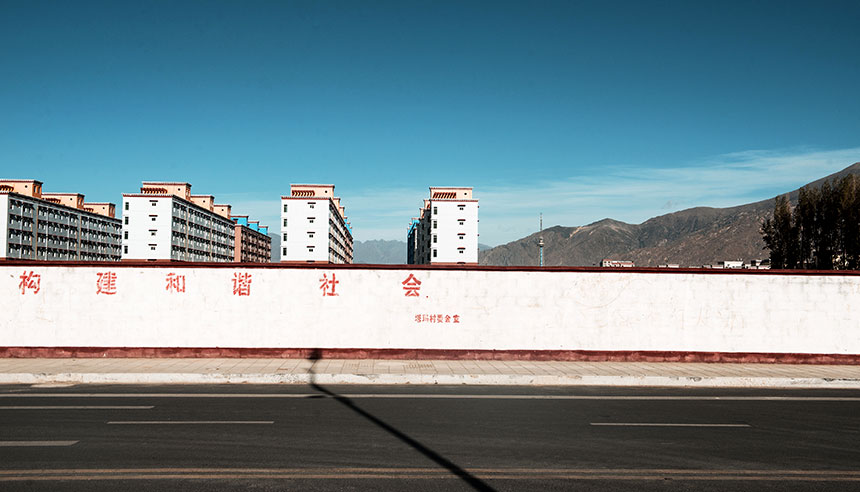
Slogan on a wall in front of new construction in Lhasa reads: “Construct a Harmonious Society”.

Slogan on a wall in front of new construction in Lhasa reads: “Construct a Harmonious Society”.
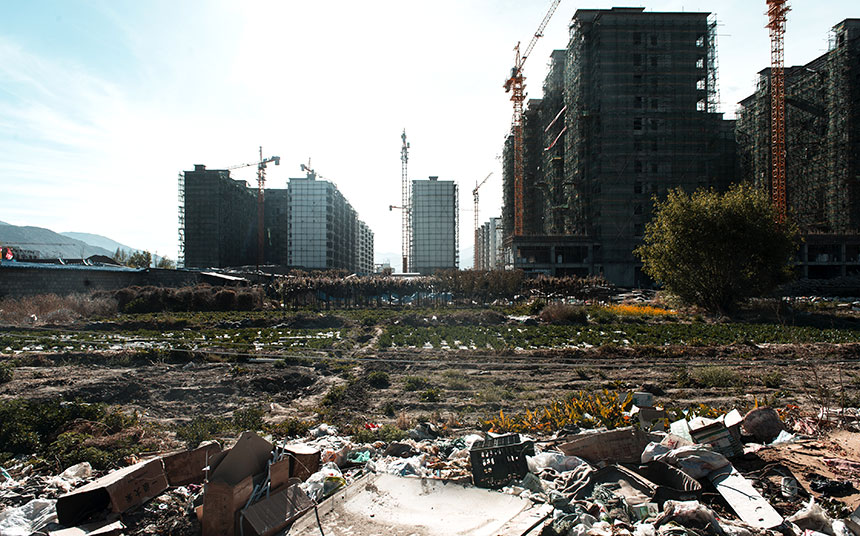
New construction, Lhasa.

New construction, Lhasa.
China’s development of Lhasa is an integral part of its policies of urbanisation in Tibet, which has been predominantly rural. Urbanisation is a key mechanism designed to meet economic objectives but with the political agenda of integrating Tibetans into the PRC, undermining ‘ethnic autonomy’ and ensuring top-down control. The intensified securitization in Tibet is dependent upon urbanisation as well as settlement of Tibetan nomads, because it makes Tibetans easier to administer and control,[50] as well as creating space for Chinese incomers.
Lhasa residents have been cited as saying that they believe they are being concentrated in such a unified fashion in new apartment complexes not only to “make space for the Chinese” but also “because people gathered together like that are easier to manage.”[51]
Both urbanization and ‘municipalisation’ – in which a rural region effectively becomes a city – were core strategies of China’s ‘Western Development’ drive under the then President Jiang Zemin in 1999-2000. But they have been advanced even more rapidly under Party Secretary Xi Jinping.
Given the high political priority ascribed to compliance with top-down planning policy, the recent Chinese State Council response on Lhasa city planning emphasized that enhanced surveillance was in place, if Lhasa citizens had any doubt: “The ‘Overall Plan’ is the fundamental basis for the development, construction and management of the city of Lhasa, and all construction activities within the urban planning district must comply with the requirements of the ‘Overall Plan’. […] Strengthen mass and social supervision, and raise awareness of social respect for urban planning. All Lhasa-based work units must respect relevant laws and the ‘Overall Plan’, support the work of the Lhasa City People’s Government, strive together, and properly plan, properly build and properly manage Lhasa City.”[52]
China’s development of Lhasa is an integral part of its policies of urbanisation in Tibet, which has been predominantly rural. Urbanisation is a key mechanism designed to meet economic objectives but with the political agenda of integrating Tibetans into the PRC, undermining ‘ethnic autonomy’ and ensuring top-down control. The intensified securitization in Tibet is dependent upon urbanisation as well as settlement of Tibetan nomads, because it makes Tibetans easier to administer and control,[50] as well as creating space for Chinese incomers.
Lhasa residents have been cited as saying that they believe they are being concentrated in such a unified fashion in new apartment complexes not only to “make space for the Chinese” but also “because people gathered together like that are easier to manage.”[51]
Both urbanization and ‘municipalisation’ – in which a rural region effectively becomes a city – were core strategies of China’s ‘Western Development’ drive under the then President Jiang Zemin in 1999-2000. But they have been advanced even more rapidly under Party Secretary Xi Jinping.
Given the high political priority ascribed to compliance with top-down planning policy, the recent Chinese State Council response on Lhasa city planning emphasized that enhanced surveillance was in place, if Lhasa citizens had any doubt: “The ‘Overall Plan’ is the fundamental basis for the development, construction and management of the city of Lhasa, and all construction activities within the urban planning district must comply with the requirements of the ‘Overall Plan’. […] Strengthen mass and social supervision, and raise awareness of social respect for urban planning. All Lhasa-based work units must respect relevant laws and the ‘Overall Plan’, support the work of the Lhasa City People’s Government, strive together, and properly plan, properly build and properly manage Lhasa City.”[52]
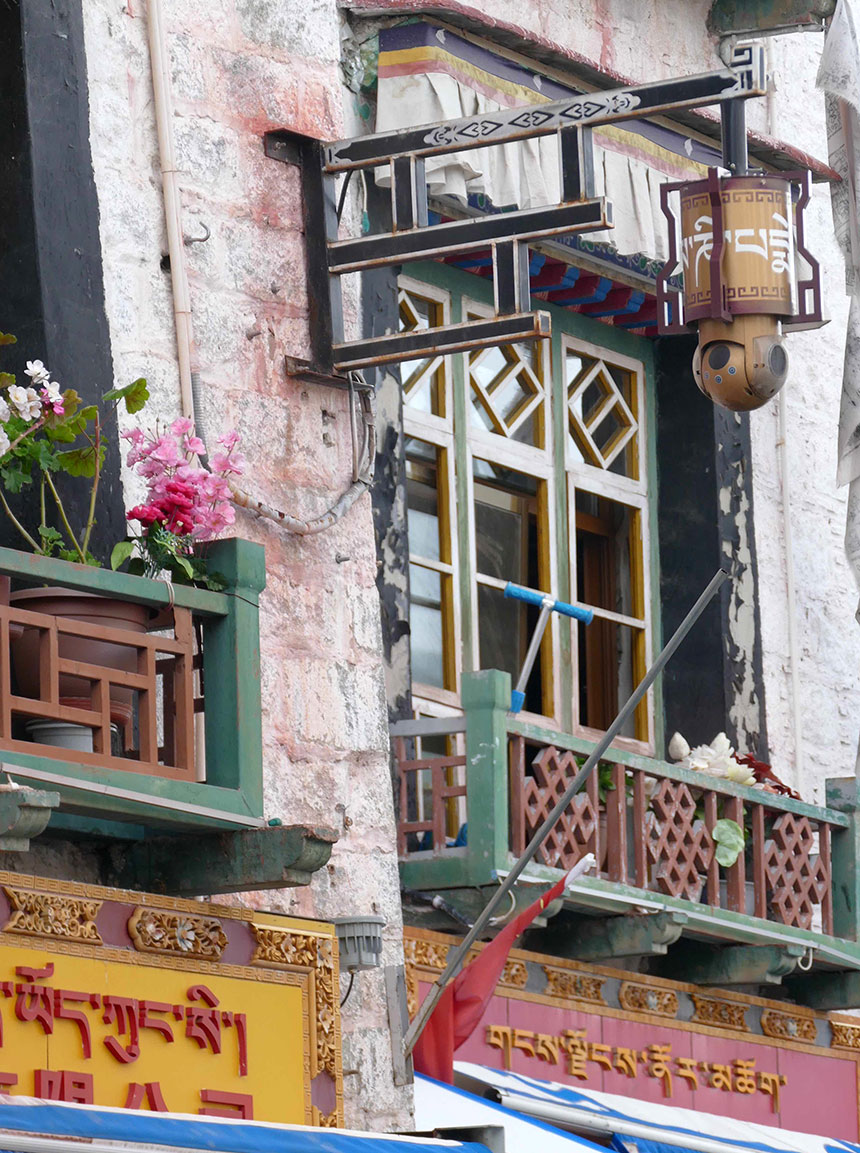
Surveillance camera disguised as a prayer wheel in the Barkhor area.

Surveillance camera disguised as a prayer wheel in the Barkhor area.
On July 8, 2016, a Tibetan official who has been leading urbanisation and development plans was cited as saying that the Chinese government would apply for the old town of Lhasa to be awarded world cultural heritage status.[53] Tibetan official Che Dalha, a former Party chief of Lhasa who is now governor of the Tibet Autonomous Region, told Xinhua: “Lhasa has more than 4,000 years of history, and is strewn with famous historical sites. It embodies the essence of Tibetan culture.”
As per UNESCO rules, China must first include old town Lhasa in a “tentative list” that indicates nominations eligible for formal inscription in the next five to ten years.[54] But it does not appear in the list published by UNESCO World Heritage on February 28, 2017, so will not be discussed in Bahrain, and further information about its inclusion on later lists is not known.
The credibility of the comment by Che Dalha is further undermined as he is one of the leading officials responsible for rapid urbanisation and expansion of the city of Lhasa, presiding over tough and repressive securitization measures in the Tibet Autonomous Region.
A senior Chinese diplomat, Qu Jing, has been appointed as Deputy Director-General of UNESCO (the United Nations Educational Scientific and Cultural Organisation), suggesting that the Chinese authorities will play an even more active role in influencing the Committee in support of their broader political aims, in which cultural heritage is a low priority. Across China, historic buildings have been razed and fake historic architecture is described as ‘heritage’ or ‘conservation’.[55] Qu Jing is a former Ambassador to France and Belgium, and his appointment at UNESCO was heralded in March (2018) by the Chinese state media as an indication of China’s increasing global influence.[56]
On July 8, 2016, a Tibetan official who has been leading urbanisation and development plans was cited as saying that the Chinese government would apply for the old town of Lhasa to be awarded world cultural heritage status.[53] Tibetan official Che Dalha, a former Party chief of Lhasa who is now governor of the Tibet Autonomous Region, told Xinhua: “Lhasa has more than 4,000 years of history, and is strewn with famous historical sites. It embodies the essence of Tibetan culture.”
As per UNESCO rules, China must first include old town Lhasa in a “tentative list” that indicates nominations eligible for formal inscription in the next five to ten years.[54] But it does not appear in the list published by UNESCO World Heritage on February 28, 2017, so will not be discussed in Bahrain, and further information about its inclusion on later lists is not known.
The credibility of the comment by Che Dalha is further undermined as he is one of the leading officials responsible for rapid urbanisation and expansion of the city of Lhasa, presiding over tough and repressive securitization measures in the Tibet Autonomous Region.
A senior Chinese diplomat, Qu Jing, has been appointed as Deputy Director-General of UNESCO (the United Nations Educational Scientific and Cultural Organisation), suggesting that the Chinese authorities will play an even more active role in influencing the Committee in support of their broader political aims, in which cultural heritage is a low priority. Across China, historic buildings have been razed and fake historic architecture is described as ‘heritage’ or ‘conservation’.[55] Qu Jing is a former Ambassador to France and Belgium, and his appointment at UNESCO was heralded in March (2018) by the Chinese state media as an indication of China’s increasing global influence.[56]
THE UNESCO BRAND AND TOURISM IN LHASA
THE UNESCO BRAND AND TOURISM IN LHASA
“…[This is] a vast project that rewrites history and ‘wipes out’ the memory and culture of an entire people.”
– Tibetan writer Tsering Woeser, August 24, 2013[57]
“…[This is] a vast project that rewrites history and ‘wipes out’ the memory and culture of an entire people.”
– Tibetan writer Tsering Woeser, August 24, 2013[57]
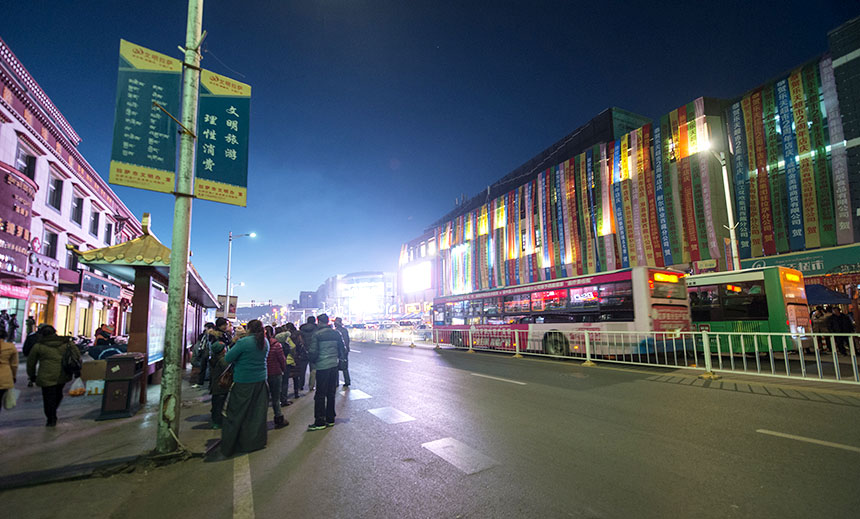
Time Square, Lhasa’s latest shopping mall on Beijing Rd, near the Potala Palace. The center includes a large supermarket, cafes and stores selling Chinese and Western brands.

Time Square, Lhasa’s latest shopping mall on Beijing Rd, near the Potala Palace. The center includes a large supermarket, cafes and stores selling Chinese and Western brands.
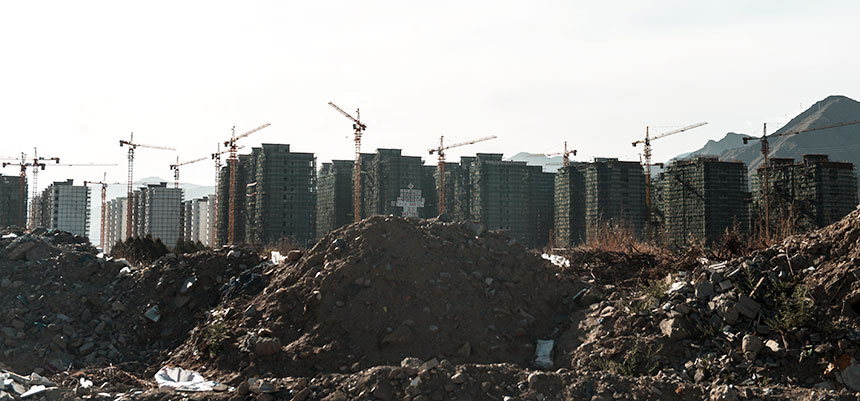
New construction to the east of Lhasa.

New construction to the east of Lhasa.
Together with urbanisation, a joint imperative underlying Lhasa’s development plans and the downgrading of authentic cultural heritage is tourism. The UNESCO World Heritage ‘brand’ is used as part of the Chinese government’s ambitious plans to boost high-end tourism in Lhasa and beyond, part of China’s strategic and economic objectives in Tibet. This endorsement has assisted the Chinese government in its claims to authority over Tibetan culture.[58]
In an unprecedented development, mass Chinese domestic tourism across Tibet now coexists with the untrammelled powers of a security state engaged in the most widespread political crackdown in a generation. Lhasa is a particular focus and all official planning documents refer to its importance.
Tibet Autonomous Region received nearly 2.7 million domestic tourists from January to April this year, up 63.5 percent from last year, according to the Chinese state media.[59] The same report said that according to the regional tourism development committee, the region received $26.7 million of tourism revenue during the period, a year-on-year increase of 50.7 percent. The figures are certainly inflated, with visitor arrivals bolstered to meet official quotas,[60] but that does not detract from the transformative impact of the rising tourist numbers to Lhasa, and it highlights how the Chinese government is capitalizing on the increased currency of Tibet’s cultural heritage.
The Chinese authorities have sought to ‘re-brand’ Tibet as a grid of tourist itineraries. The creation of a series of ‘tour circuits’ has been backed up by massive infrastructure investment funded by Beijing, not only the railway to Lhasa and Shigatse, but also regional airports giving tourists glimpses of Tibet’s variety of landscapes, architecture, wildlife and heritage.
Lhasa is critical to China’s 2010-2020 tourism strategy, which names the two main markets as “human culture tourism” and “ecotourism”, with “boutique tourist routes” and “safari tourism” for adventurous travellers seeking wild landscapes.
At last year’s World Heritage Committee meeting in Poland, UNESCO status was given to Hoh Xil (Chinese: Kekexili), a wild landscape between Golmud in Qinghai and Lhasa, consistent with China’s objectives to increase mass tourism to Tibet’s wilderness areas. China’s official nomination proposal required UNESCO World Heritage Committee members to accept a framework that specifically labelled traditional pastoral land-use a threat, involving the criminalization of traditional productive and sustainable activities as pastoralism and gathering medicinal herbs.[61]
The ‘commodification’ or commercialization of Tibetan culture – while the authentic culture is being undermined by Chinese policies targeting Tibetan religious identity – was evident during a Tourism Expo in Lhasa, which included a ‘re-imagining’ of the deeply symbolic former home of the Dalai Lama, the Potala Palace, in the InterContinental Hotel lobby.[62] Tibetans are increasingly marginalised by the use of Chinese as the language of tourism in Tibet, providing employment for large numbers of Chinese immigrants in a labor-intensive industry.
Tibetan writer Tsering Woeser is one of the most eloquent and astute writers on the transformation of the city of Lhasa, from the Cultural Revolution – when her father was an official photographer – to today. She says: “Comparing today with the Cultural Revolution, there were no believers kneeling back then, and the temple was ruined, while today the temple offers a bustling scene where believers may freely worship. But these are only superficial differences. Religious worship is still strictly controlled. Furthermore, there is now commercialized tourism, with gawking tourists who treat Tibetans like exotic decorations and Lhasa as a theme park.”[63]
Together with urbanisation, a joint imperative underlying Lhasa’s development plans and the downgrading of authentic cultural heritage is tourism. The UNESCO World Heritage ‘brand’ is used as part of the Chinese government’s ambitious plans to boost high-end tourism in Lhasa and beyond, part of China’s strategic and economic objectives in Tibet. This endorsement has assisted the Chinese government in its claims to authority over Tibetan culture.[58]
In an unprecedented development, mass Chinese domestic tourism across Tibet now coexists with the untrammelled powers of a security state engaged in the most widespread political crackdown in a generation. Lhasa is a particular focus and all official planning documents refer to its importance.
Tibet Autonomous Region received nearly 2.7 million domestic tourists from January to April this year, up 63.5 percent from last year, according to the Chinese state media.[59] The same report said that according to the regional tourism development committee, the region received $26.7 million of tourism revenue during the period, a year-on-year increase of 50.7 percent. The figures are certainly inflated, with visitor arrivals bolstered to meet official quotas,[60] but that does not detract from the transformative impact of the rising tourist numbers to Lhasa, and it highlights how the Chinese government is capitalizing on the increased currency of Tibet’s cultural heritage.
The Chinese authorities have sought to ‘re-brand’ Tibet as a grid of tourist itineraries. The creation of a series of ‘tour circuits’ has been backed up by massive infrastructure investment funded by Beijing, not only the railway to Lhasa and Shigatse, but also regional airports giving tourists glimpses of Tibet’s variety of landscapes, architecture, wildlife and heritage.
Lhasa is critical to China’s 2010-2020 tourism strategy, which names the two main markets as “human culture tourism” and “ecotourism”, with “boutique tourist routes” and “safari tourism” for adventurous travellers seeking wild landscapes.
At last year’s World Heritage Committee meeting in Poland, UNESCO status was given to Hoh Xil (Chinese: Kekexili), a wild landscape between Golmud in Qinghai and Lhasa, consistent with China’s objectives to increase mass tourism to Tibet’s wilderness areas. China’s official nomination proposal required UNESCO World Heritage Committee members to accept a framework that specifically labelled traditional pastoral land-use a threat, involving the criminalization of traditional productive and sustainable activities as pastoralism and gathering medicinal herbs.[61]
The ‘commodification’ or commercialization of Tibetan culture – while the authentic culture is being undermined by Chinese policies targeting Tibetan religious identity – was evident during a Tourism Expo in Lhasa, which included a ‘re-imagining’ of the deeply symbolic former home of the Dalai Lama, the Potala Palace, in the InterContinental Hotel lobby.[62] Tibetans are increasingly marginalised by the use of Chinese as the language of tourism in Tibet, providing employment for large numbers of Chinese immigrants in a labor-intensive industry.
Tibetan writer Tsering Woeser is one of the most eloquent and astute writers on the transformation of the city of Lhasa, from the Cultural Revolution – when her father was an official photographer – to today. She says: “Comparing today with the Cultural Revolution, there were no believers kneeling back then, and the temple was ruined, while today the temple offers a bustling scene where believers may freely worship. But these are only superficial differences. Religious worship is still strictly controlled. Furthermore, there is now commercialized tourism, with gawking tourists who treat Tibetans like exotic decorations and Lhasa as a theme park.”[63]
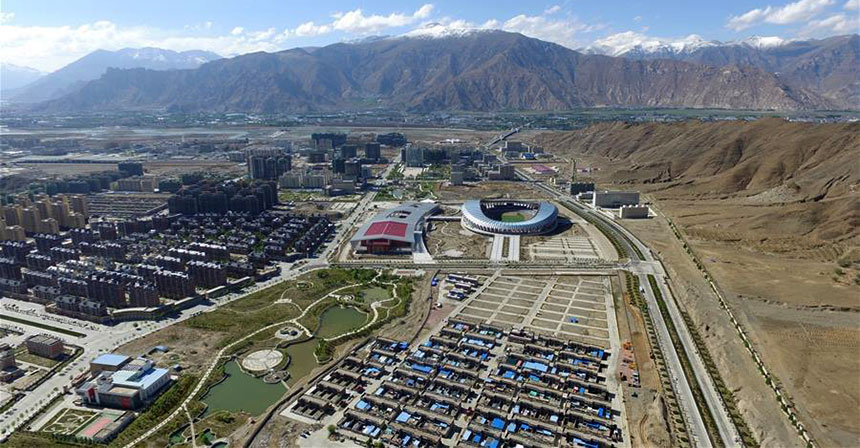
New construction in the Tibetan village of Drip, that has resulted in relocations. One Tibetan reported losing all his farmland when the Princess Wencheng spectacle for Chinese tourists opened opposite the Potala Palace.

New construction in the Tibetan village of Drip, that has resulted in relocations. One Tibetan reported losing all his farmland when the Princess Wencheng spectacle for Chinese tourists opened opposite the Potala Palace.
Referring to the Chinese government’s creation of ‘fake’ Tibetan architecture such as the fake Potala Palace used for a show presenting China’s narrative on Tibet, Tsering Woeser wrote: “In fact, this is a vast project that rewrites history and ‘wipes out’ the memory and culture of an entire people. For many years, supported by power and money, these kinds of projects have been blossoming everywhere, sweeping everything away. One can predict that this commercial theatre play put on stage in a fake Potala Palace will be a must-see of future tourist groups visiting Lhasa. They can brainwash people and make money at the same time. Those that will be harmed, however, are the Tibetans who have been invaded and deprived of their history.”[64]
In 2013, more than 200 scholars in countries across the world voiced strong concern about a project to modernize the historic center of Lhasa linked to the development of tourist infrastructure. “This destruction is not simply a matter of aesthetics,” said the petition, addressed to China’s president Xi Jinping and to UNESCO director-general Irina Bukova. “It is depriving Tibetans and scholars of Tibet alike of a living connection to the Tibetan past. […] It is bringing in its wake the forced displacement of large numbers of Tibetans from their own homes, effectively diminishing the Tibetan presence in one of the most important Tibetan cultural sites.”[65]
The Central Tibetan Administration (CTA) based in India said that it was “deeply concerned” about the project’s impact, saying it is transforming Lhasa’s central Jokhang temple and the Barkhor, or Old City, around it into a “superficial tourist spot.”[66]
Referring to the Chinese government’s creation of ‘fake’ Tibetan architecture such as the fake Potala Palace used for a show presenting China’s narrative on Tibet, Tsering Woeser wrote: “In fact, this is a vast project that rewrites history and ‘wipes out’ the memory and culture of an entire people. For many years, supported by power and money, these kinds of projects have been blossoming everywhere, sweeping everything away. One can predict that this commercial theatre play put on stage in a fake Potala Palace will be a must-see of future tourist groups visiting Lhasa. They can brainwash people and make money at the same time. Those that will be harmed, however, are the Tibetans who have been invaded and deprived of their history.”[64]
In 2013, more than 200 scholars in countries across the world voiced strong concern about a project to modernize the historic center of Lhasa linked to the development of tourist infrastructure. “This destruction is not simply a matter of aesthetics,” said the petition, addressed to China’s president Xi Jinping and to UNESCO director-general Irina Bukova. “It is depriving Tibetans and scholars of Tibet alike of a living connection to the Tibetan past. […] It is bringing in its wake the forced displacement of large numbers of Tibetans from their own homes, effectively diminishing the Tibetan presence in one of the most important Tibetan cultural sites.”[65]
The Central Tibetan Administration (CTA) based in India said that it was “deeply concerned” about the project’s impact, saying it is transforming Lhasa’s central Jokhang temple and the Barkhor, or Old City, around it into a “superficial tourist spot.”[66]
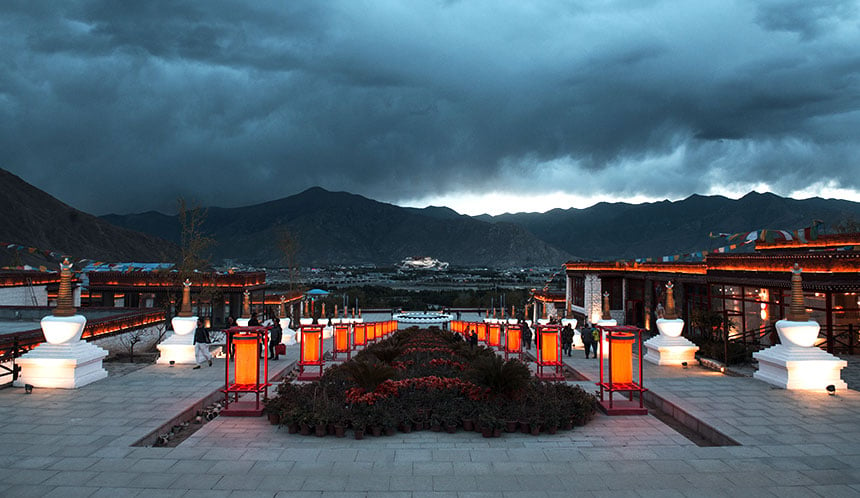
The Princess Wencheng spectacle opposite the Potala Palace. The multi million dollar spectacle is a state-scripted narrative in which the Chinese, embodied by Princess Wencheng of the 7th century, ‘civilise’ the Tibetans and bring harmony to Tibet. It is designed to boost mass domestic tourism.

The Princess Wencheng spectacle opposite the Potala Palace. The multi million dollar spectacle is a state-scripted narrative in which the Chinese, embodied by Princess Wencheng of the 7th century, ‘civilise’ the Tibetans and bring harmony to Tibet. It is designed to boost mass domestic tourism.

The Princess Wencheng spectacle entrance in eastern Lhasa. Tibetan writer Tsering Woeser wrote in 2014: “For many years, supported by power and money, these kinds of projects have been blossoming everywhere, sweeping everything away. One can predict that this commercial theatre play put on stage in a fake Potala Palace will be a must-see of future tourist groups visiting Lhasa. They can brainwash people and make money at the same time. Those that will be harmed, however, are the Tibetans who have been invaded and deprived of their history.” (http://highpeakspureearth.com/2014/a-fake-potala-palace-and-the-myth-of-princess-wencheng-by-woeser/)

The Princess Wencheng spectacle entrance in eastern Lhasa. Tibetan writer Tsering Woeser wrote in 2014: “For many years, supported by power and money, these kinds of projects have been blossoming everywhere, sweeping everything away. One can predict that this commercial theatre play put on stage in a fake Potala Palace will be a must-see of future tourist groups visiting Lhasa. They can brainwash people and make money at the same time. Those that will be harmed, however, are the Tibetans who have been invaded and deprived of their history.” (http://highpeakspureearth.com/2014/a-fake-potala-palace-and-the-myth-of-princess-wencheng-by-woeser/)
BACKGROUND: THE DESTRUCTION OF OLD LHASA
After full Chinese Communist rule was imposed in 1959, many private houses, monasteries and other buildings in Lhasa were confiscated and nationalized.
The carnage of the Cultural Revolution (1966-76) is well-documented. Tubten Khetsun, a Lhasa resident, described Lhasa at this time in a biography: “Formerly, it was the splendid Potala Palace and the [Jokhang] Temple that stood at the center of the Lhasa Dharmachakra, and of Tibet as a whole, as the supreme field of merit for all living beings, blazing with the power of blessing, surrounded by the dwellings of the common people beautified with the characteristic features of their tradition […] Now, the old city that had not been whitewashed for a long time but left to decay seemed dark and grimy; it had been encircled by ugly Chinese buildings with corrugated iron roofs and was filled with ruins of destroyed monasteries and temples. Wherever you went, instead of seeing attractive people or hearing pleasant talk, there was only the din of killing, chopping and beating, and the majority of citizens lived in hunger, fear and fatigue.”[67]
It was only after Lhasa was considered to be one of China’s 24 historic cities and the Lhasa 2000 masterplan was approved in 1983, that dramatic changes began to happen to the cityscape. In the 1990s, Andre Alexander founded the Lhasa Archive Project in order to document the historic buildings, and in 1994 the Potala Palace was listed for nomination to the UNESCO Heritage list. Although it was hoped that this listing would protect the historic village of Shol at the foot of the Potala, it did not.
In 1996, the Tibet Heritage Fund was accepted by the municipal government as a partner, beginning a successful community-based conservation approach that led to 93 buildings being listed as protected in 1998. In 2000, the situation began to deteriorate with the expulsion of the Tibet Heritage Fund from Lhasa. Both the municipality and the Cultural Relics Bureau soon after gave permission for the demolition of the historically significant Ganden Khangsar building, Samtong and Jamyang Kyil. In 2001-2002, two clusters of historic buildings in the Barkhor and Shasarzur neighbourhoods were demolished.[68]
According to Pimpim de Azevedo and Andre Alexander, “Important efforts were made by the municipality to preserve the old city’s vernacular buildings, but these attempts have not succeeded, and out of the 93 protected buildings only 56 exist today. A report was made by China’s Central Construction and Planning Authority recommending that the old city should be preserved as a ‘historical area’, but the same recommendations also said that the old traditional buildings were ‘dangerous or unsafe housing that needed to be ‘replaced’. This gave the developers an excuse to replace the buildings. The new buildings were built of concrete with painted cement decorations to resemble the decorations of the old buildings, and had three to four storys.
“[This] does not fit with the approach to historic towns of the UNESCO World Heritage status. […] To preserve the existing historic vernacular buildings it is necessary to change the present approach without delay into a conservation approach, monitored by the regional and national Cultural Relics Departments together with UNESCO to ensure that conservation objectives are met and the integrity of the World Heritage Sites preserved. Furthermore, they should give strict guidelines to ensure that the sites’ integrity and authenticity are protected.”[69]
BACKGROUND: THE DESTRUCTION OF OLD LHASA
After full Chinese Communist rule was imposed in 1959, many private houses, monasteries and other buildings in Lhasa were confiscated and nationalized.
The carnage of the Cultural Revolution (1966-76) is well-documented. Tubten Khetsun, a Lhasa resident, described Lhasa at this time in a biography: “Formerly, it was the splendid Potala Palace and the [Jokhang] Temple that stood at the center of the Lhasa Dharmachakra, and of Tibet as a whole, as the supreme field of merit for all living beings, blazing with the power of blessing, surrounded by the dwellings of the common people beautified with the characteristic features of their tradition […] Now, the old city that had not been whitewashed for a long time but left to decay seemed dark and grimy; it had been encircled by ugly Chinese buildings with corrugated iron roofs and was filled with ruins of destroyed monasteries and temples. Wherever you went, instead of seeing attractive people or hearing pleasant talk, there was only the din of killing, chopping and beating, and the majority of citizens lived in hunger, fear and fatigue.”[67]
It was only after Lhasa was considered to be one of China’s 24 historic cities and the Lhasa 2000 masterplan was approved in 1983, that dramatic changes began to happen to the cityscape. In the 1990s, Andre Alexander founded the Lhasa Archive Project in order to document the historic buildings, and in 1994 the Potala Palace was listed for nomination to the UNESCO Heritage list. Although it was hoped that this listing would protect the historic village of Shol at the foot of the Potala, it did not.
In 1996, the Tibet Heritage Fund was accepted by the municipal government as a partner, beginning a successful community-based conservation approach that led to 93 buildings being listed as protected in 1998. In 2000, the situation began to deteriorate with the expulsion of the Tibet Heritage Fund from Lhasa. Both the municipality and the Cultural Relics Bureau soon after gave permission for the demolition of the historically significant Ganden Khangsar building, Samtong and Jamyang Kyil. In 2001-2002, two clusters of historic buildings in the Barkhor and Shasarzur neighbourhoods were demolished.[68]
According to Pimpim de Azevedo and Andre Alexander, “Important efforts were made by the municipality to preserve the old city’s vernacular buildings, but these attempts have not succeeded, and out of the 93 protected buildings only 56 exist today. A report was made by China’s Central Construction and Planning Authority recommending that the old city should be preserved as a ‘historical area’, but the same recommendations also said that the old traditional buildings were ‘dangerous or unsafe housing that needed to be ‘replaced’. This gave the developers an excuse to replace the buildings. The new buildings were built of concrete with painted cement decorations to resemble the decorations of the old buildings, and had three to four storys.
“[This] does not fit with the approach to historic towns of the UNESCO World Heritage status. […] To preserve the existing historic vernacular buildings it is necessary to change the present approach without delay into a conservation approach, monitored by the regional and national Cultural Relics Departments together with UNESCO to ensure that conservation objectives are met and the integrity of the World Heritage Sites preserved. Furthermore, they should give strict guidelines to ensure that the sites’ integrity and authenticity are protected.”[69]
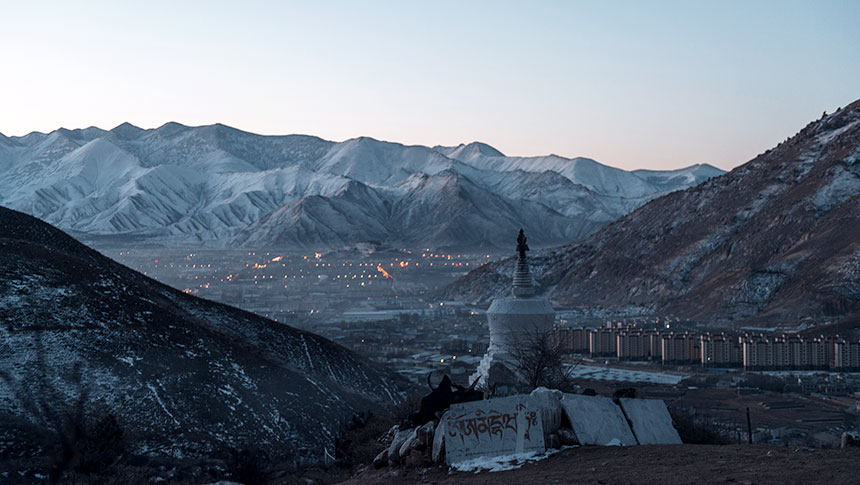
New developments can be seen beyond a stupa at Pabongkha monastery.

New developments can be seen beyond a stupa at Pabongkha monastery.
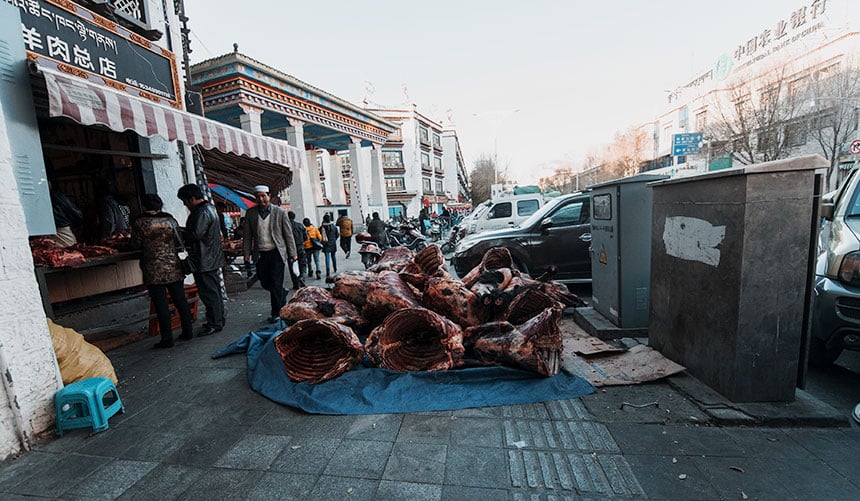
Chinese Hui Muslims selling meat on the streets of Lhasa.

Chinese Hui Muslims selling meat on the streets of Lhasa.

Recent cityscape, Lhasa.

Recent cityscape, Lhasa.
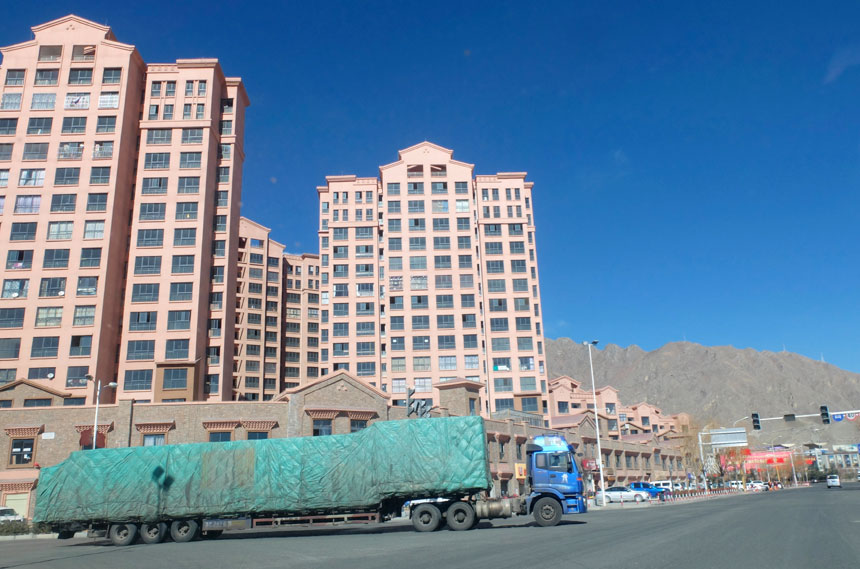
New construction in the Toelung area of Lhasa. The building of the railway station in 2005 involved the relocation of local residents in the area of Ne’u (Chinese: Liuwu) township in Toelung Dechen county (Chinese: Duilongdeqing). (International Campaign for Tibet report ‘Tracking the Steel Dragon’).

New construction in the Toelung area of Lhasa. The building of the railway station in 2005 involved the relocation of local residents in the area of Ne’u (Chinese: Liuwu) township in Toelung Dechen county (Chinese: Duilongdeqing). (International Campaign for Tibet report ‘Tracking the Steel Dragon’).
RECOMMENDATIONS TO UNESCO, THE WORLD HERITAGE COMMITTEE, THE UNESCO WORLD HERITAGE CENTER AND ITS ADVISORY BODIES
- It is of urgent importance to protect the few existing historic buildings in Lhasa. The UNESCO World Heritage Committee should press the Chinese state party towards a conservation approach in order for the remaining fragments of old Lhasa to be preserved.
- The UNESCO World Heritage Committee should provide strict guidelines on protecting the historic Barkhor area and buildings in the Potala Palace Historic Ensemble, to ensure that conservation objectives are met and the integrity of World Heritage Sites preserved. The guidelines should be based on a clear definition of buffer zones and detailed plan for protection of the few remaining traditional buildings and temples. It should be noted that authentic cultural heritage is a tourism asset.
- The Committee should press for the answers to questions about the damage from the Jokhang fire of February 17 as a matter of urgency, and seek access for a UNESCO delegation to Lhasa for independent verification of the status of the unique and precious architecture, and its statues and murals, particularly the Jowo Rinpoche statue,[70] with a view to ensuring that repair work is conducted under the supervision of accredited conservation experts.
- The Committee should press for the active engagement of Tibetan artisans and experts in conservation efforts, seeking to revitalize rather than museumize private and public Tibetan spaces.
- The Committee should hold the Chinese authorities to account over its apparent exclusion of Tibetan civil society in conservation issues and its top-down management of Tibetan historic and cultural sites, which are not consistent with UNESCO tenets of cultural diversity and rights. (UNESCO Universal Declaration on Cultural Diversity, 2001: “The defence of cultural diversity is an ethical imperative, inseparable from respect for human dignity. It implies a commitment to human rights and fundamental freedoms, in particular the rights of persons belonging to minorities and those of indigenous peoples.”)[71]
- In the Urban Plan for Lhasa (2007-2020), the Ensemble area is designated as one of the main areas for “improvement” in the “short-term construction plan”. The Committee should press for answers about what this involves and ensure that preservation of historic buildings are a focus of the plans.
RECOMMENDATIONS TO UNESCO, THE WORLD HERITAGE COMMITTEE, THE UNESCO WORLD HERITAGE CENTER AND ITS ADVISORY BODIES
- It is of urgent importance to protect the few existing historic buildings in Lhasa. The UNESCO World Heritage Committee should press the Chinese state party towards a conservation approach in order for the remaining fragments of old Lhasa to be preserved.
- The UNESCO World Heritage Committee should provide strict guidelines on protecting the historic Barkhor area and buildings in the Potala Palace Historic Ensemble, to ensure that conservation objectives are met and the integrity of World Heritage Sites preserved. The guidelines should be based on a clear definition of buffer zones and detailed plan for protection of the few remaining traditional buildings and temples. It should be noted that authentic cultural heritage is a tourism asset.
- The Committee should press for the answers to questions about the damage from the Jokhang fire of February 17 as a matter of urgency, and seek access for a UNESCO delegation to Lhasa for independent verification of the status of the unique and precious architecture, and its statues and murals, particularly the Jowo Rinpoche statue,[70] with a view to ensuring that repair work is conducted under the supervision of accredited conservation experts.
- The Committee should press for the active engagement of Tibetan artisans and experts in conservation efforts, seeking to revitalize rather than museumize private and public Tibetan spaces.
- The Committee should hold the Chinese authorities to account over its apparent exclusion of Tibetan civil society in conservation issues and its top-down management of Tibetan historic and cultural sites, which are not consistent with UNESCO tenets of cultural diversity and rights. (UNESCO Universal Declaration on Cultural Diversity, 2001: “The defence of cultural diversity is an ethical imperative, inseparable from respect for human dignity. It implies a commitment to human rights and fundamental freedoms, in particular the rights of persons belonging to minorities and those of indigenous peoples.”)[71]
- In the Urban Plan for Lhasa (2007-2020), the Ensemble area is designated as one of the main areas for “improvement” in the “short-term construction plan”. The Committee should press for answers about what this involves and ensure that preservation of historic buildings are a focus of the plans.
Footnotes:
[1] Document WHC/18/42.COM/7B.Add.
[2] The request, that may indicate some concern over the implications of the rapid development of Lhasa, was made at the 40th Session of World Heritage Committee in Istanbul, 2016: Historic Ensemble of the Potala Palace, Lhasa (China) (C 707), detailed in the document: ‘World Heritage Historic Ensemble of the Potala Palace, Lhasa (C 707), State of Conservation 2017’, State Administration of Cultural Heritage, PRC, November 2017.
[3] See for further details, UNESCO, ’Operational Guidelines for the Implementation of the World Heritage Convention’, WHC.17/01 12 July 2017, paras. 103-107; para. 103 states: “For the purposes of effective protection of the nominated property, a buffer zone is an area surrounding the nominated property which has complementary legal and/or customary restrictions placed on its use and development to give an added layer of protection to the property. This should include the immediate setting of the nominated property, important views and other areas or attributes that are functionally important as a support to the property and its protection. The area constituting the buffer zone should be determined in each case through appropriate mechanisms. Details on the size, characteristics and authorized uses of a buffer zone, as well as a map indicating the precise boundaries of the property and its buffer zone, should be provided in the nomination.”
[4] UNESCO, ’Operational Guidelines for the Implementation of the World Heritage Convention’ WHC.17/01 12 July 2017, para. 107.
[5] ‘World Heritage: Heritage Ensemble of the Potala Palace, Lhasa (C707), State of Conservation 2017’, State Administration of Cultural Heritage, PRC, November 2017. The same report describes the three as follows: “The beauty and originality of the architecture of these three sites, their rich ornamentation and harmonious integration in a striking landscape, add to their historic and religious interest.”
[6] ‘World Heritage Historic Ensemble of the Potala Palace, Lhasa (C 707) State of Conservation 2017’, State Administration of Cultural Heritage, PRC November 2017, https://whc.unesco.org/document/165238
[7] Cooperation of the Tibet Heritage Fund work collaborating with the Lhasa Cultural Relics Bureau to rehabilitate and preserve an important neighborhood of old Lhasa was cut short in 2000 when the organization was expelled from Tibet after years of successful work.
[8] ‘The Traditional Lhasa House: Typology of an Endangered Species’ by Andre Alexander, the Habitat International Series, Lit Verlag, Berlin, 2011.
[9] ‘The Lhasa Jokhang – is the world’s oldest timber-framed building in Tibet?’ by Andre Alexander, http://www.tibetheritagefund.org/media/download/Articolo_8_Alexander.pdf (PDF), p. 172.
[10] International Campaign for Tibet, ‘New fears for historic structure of Jokhang temple after major fire, as China covers up extent of damage’, March 12, 2018, https://www.https://savetibet.org/new-fears-for-historic-structure-of-jokhang-temple-after-major-fire-as-china-covers-up-extent-of-damage/
[11] According to a Western traveller to Tibet whose name is known to ICT.
[12] A survey by Austrian engineer Peter Aufschnaiter (who was in Tibet together with Heinrich Harrer, after escaping from internment in British India) noted 900 houses in the area of Lhasa, with 700 buildings in the city proper. The city consisted of palaces, monasteries, temples, shrines, office buildings and residential houses, and the houses were privately owned. ‘Tibetan Old Buildings and Urban Development in Lhasa: 1948-1985-1998’, Lhasa Archive (no longer available online). ‘The Traditional Lhasa House: Typology of an Endangered Species’ by Andre Alexander, the Habitat International Series, Lit Verlag, Berlin, 2011.
[13] ‘Lessons from the Attempt to Conserve the Architectural Heritage of Lhasa’s Old Town’, by Pimpim de Azevedo and Andre Alexander, Tibet Heritage Fund, published by World Heritage Watch, 2015, pp 89-91, http://openarchive.icomos.org/1692/
[15] In 1961 and 1988, the State Council of China announced that the Potala Palace, the Jokhang Temple and the Norbulingka were designated State Priority Protected Sites, according to the ‘Report on the State of Conservation of The Historic Ensemble of the Potala Palace (China),’ Convention Concerning the Protection of the World Cultural and Natural Heritage Cultural Heritage: China, SACH SoC 2015 4/5, State Administration of Cultural Heritage, People’s Republic of China, November 2015. The same report stated that the Chinese governments at all levels have made a series of efforts in recent years to ensure the “authenticity and integrity of the World Heritage Property, including: approved Old Town of Lhasa (Barkhor Historic Area) as ‘National Historically and Culturally Famous City’ and listed buildings inside the buffer zone of Jokhang Temple as Priority Protected Sites at different levels.”
[16] World Heritage Watch, 2015: ‘Lessons from the Attempt to Conserve the Architectural Heritage of Lhasa’s Old Town,’ page 89-91, http://openarchive.icomos.org/1692/
[17] ‘The Traditional Lhasa House: Typology of an Endangered Species’ by Andre Alexander, the Habitat International Series, Lit Verlag, Berlin, 2011.
[18] ‘World Heritage Historic Ensemble of the Potala Palace, Lhasa (C 707) State of Conservation 2017,’ State Administration of Cultural Heritage, PRC November 2017, https://whc.unesco.org/document/165238
[19] ‘Decision of World Heritage Committee, the 40th session of World Heritage Committee (Istanbul, 2016), Historic Ensemble of the Potala Palace, Lhasa (China) (C708), https://whc.unesco.org/document/165238
[20] ‘Decision of World Heritage Committee, the 40th session of World Heritage Committee (Istanbul, 2016), Historic Ensemble of the Potala Palace, Lhasa (China) (C708), https://whc.unesco.org/document/165238
[21] ‘Overall Urban Plan for Lhasa (2007-2020) (Revision)’, Lhasa Municipal Bureau of Land and Resources, revision dated June, 2008. Copy obtained in Chinese and translated into English by the International Campaign for Tibet (see appendix).
[22] ‘Stabilizing the city with rule of law to achieve harmony and stability in Lhasa’, interview with Qi Zhala, People’s Daily Online, May 26, 2014, http://en.people.cn/n/2014/0526/c309805-8732709-5.html
[23] The Chinese authorities have specified that the main highway leading out of Lhasa to Nyingtri (Chinese: Nyingchi) is classified as a “first-tier highway”, which “can be used by armoured vehicles and as a runway for planes to take off when it has to serve a military purpose.” Zhao Gancheng, director of the Centre for Asia-Pacific Studies at the Shanghai Institute for International Studies, was quoted in The Economic Times, India, ‘China opens dual-use highway to Nepal via Tibet’, September 17, 2017, https://economictimes.indiatimes.com/news/international/world-news/china-opens-dual-use-highway-to-nepal-via-tibet/articleshow/60730104.cms For more information on the distinction between a regular highway and a highway used as an airport runway, see Claude Arpi’s blog posted on June 6, 2014, at: http://claudearpi.blogspot.com/2014/06/the-highway-to-indian-border.html, citing China Military Online.
[24] ‘Overall Urban Plan for Lhasa (2007-2020) (Revision)’, Lhasa Municipal Bureau of Land and Resources, revision dated June, 2008.
[25] Emily T. Yeh, ‘Taming Tibet: Landscape Transformation and the Gift of Chinese Development’, 2013, Cornell University Press.
[26] ‘State Council Response on Lhasa City Overall Urban Planning’, State Council Correspondence [2017] No. 112, issued August 8, 2017. Translated into English from Chinese by the International Campaign for Tibet.
[27] ‘Tender Notice: Lhasa City’s Old City Reconstruction Strategic Planning Project Bidding number: XZZB-CQDY-LS18-03-1.’
[28] ‘State Council Response on Lhasa City Overall Urban Planning’, State Council Correspondence [2017] No. 112, issued August 8, 2017. Translated into English from Chinese by the International Campaign for Tibet.
[29] Citing Seung-jin Chung and Chang-Sung Kim, ‘The development of attitudes to historic conservation – from Eurocentrism to cultural diversity’, Architectural research, Vol 12, No 1 (June 2010), pp 25-32.
[30] ‘Lessons from the Attempt to Conserve the Architectural Heritage of Lhasa’s Old Town’, by Pimpim de Azevedo and Andre Alexander, Tibet Heritage Fund, published by World Heritage Watch, 2015, pp 89-91, http://openarchive.icomos.org/1692/
[32] ‘The Lhasa Jokhang – is the world’s oldest timber-framed building in Tibet?’ by Andre Alexander, http://www.tibetheritagefund.org/media/download/Articolo_8_Alexander.pdf (PDF).
[33] According to a Western visitor to Lhasa who has undertaken the pilgrimage on numerous occasions.
[34] Decision of World Heritage Committee, The 40th Session of World Heritage Committee (Istanbul, 2016), Historic Ensemble of the Potala Palace, Lhasa (China) (C 707), ibid.
[35] A half hour delay in fighting the fire is also still unexplained, given that China told the UNESCO World Heritage Committee in December (2017) that the Jokhang Temple has its own fire brigade, based 24 hours at the building, “for the safety and protection of cultural relics.” International Campaign for Tibet report, ‘New fears for historic structure of Jokhang temple after major fire, as China covers up extent of damage’, March 12, 2018, https://www.https://savetibet.org/new-fears-for-historic-structure-of-jokhang-temple-after-major-fire-as-china-covers-up-extent-of-damage/
[36] Historic Ensemble of the Potala Palace, Lhasa (China) (C 707ter), Document WHC/18/42.COM/7B (late supplementary information), https://whc.unesco.org/archive/2018/whc18-42com-7B-en.pdf
[37] See International Campaign for Tibet report, “Access Denied: China’s enforced isolation of Tibet, and the case for reciprocity”, https://www.https://savetibet.org/access-denied-chinas-enforced-isolation-of-tibet-and-the-case-for-reciprocity/
[38] Historic Ensemble of the Potala Palace, Lhasa (China) (C 707ter), Document WHC/18/42.COM/7B (late supplementary information), https://whc.unesco.org/archive/2018/whc18-42com-7B-en.pdf
[39] ‘World Heritage Historic Ensemble of the Potala Palace, Lhasa (C 707) State of Conservation 2017’, State Administration of Cultural Heritage, PRC November 2017, https://whc.unesco.org/document/165238
[40] Emily Yeh analyses development in Tibet as “a hegemonic project” in that it secures the leadership of the dominant, ruling Party. See ‘Taming Tibet: Landscape Transformation and the Gift of Chinese Development’, Emily T Yeh, 2013, Cornell University Press.
[41] The clause reads: “The city’s urban planning departments shall implement unified and strict management planning over all construction land use and construction activities within the scope of the urban planning area (including all forms of development zone), and city-level planning management may not be delegated down, effectively ensuring the implementation of the plan.” ‘State Council Response on Lhasa City Overall Urban Planning’, State Council Correspondence [2017] No. 112, issued August 8, 2017.
[42] ‘State Council Response on Lhasa City Overall Urban Planning’, State Council Correspondence [2017] No. 112, issued August 8, 2017. Translated into English from Chinese by the International Campaign for Tibet.
[43] Analysing CCP statements at the 19th Party Congress in Beijing in October (2017) compared to previous high-level meetings, ChinaFile Senior Editor Jessica Batke, an expert on China’s domestic political and social affairs, concluded that: “In the context of the ongoing and overwhelming securitization of both Tibet and Xinjiang […] It appears that the PRC’s perceived security needs have finally trumped the CCP’s historical attachment to the idea that it supports and represents all the country’s ethnic groups equally. Thus this report [from the 2017 Party Congress] may signal the point at which even nominal support for protecting ethnic minority culture begins to fade away, being subsumed by the notion of the ‘Chinese race’.” Jessica Batke, ‘Party All the Time: Governance and Society in the New Era,’ China Leadership Monitor No 55, Winter 2018, https://www.hoover.org/research/party-all-time-governance-and-society-new-era
[44] International Campaign for Tibet report, ‘Chinese police circular urges public to report on loyalty to ‘evil forces’ of Dalai Lama’, February 13, 2018, https://www.https://savetibet.org/chinese-police-circular-urges-public-to-report-on-loyalty-to-evil-forces-of-dalai-lama/
[45] Francoise Robin, ‘The Silence of the State: the Jokhang fire and the response of the Chinese government’, posted on High Peaks Pure Earth on March 21, 2018, http://highpeakspureearth.com/2018/guest-post-the-silence-of-the-state-the-jokhang-fire-and-the-response-of-the-chinese-government-by-francoise-robin/
[46] Tibetologist Robbie Barnett detailed the dripfeed of details and misinformation on his Twitter feed, saying: “Within two hours some WeChat posts from supposed eyewitnesses in Lhasa appeared, saying that the fire was not at the Jokhang but at an adjoining temple compound, the Meru Nyingpa. Some posts stated categorically that no part of the Jokhang had been touched by the fire.” (@robbiebarnett). Also see China Digital Times, ‘Almost total suppression of information about Tibet temple fire’, https://chinadigitaltimes.net/2018/02/almost-total-suppression-information-tibet-temple-fire/
[48] World Tibet Network News, August 16, 2000, ‘International NGO told to shut down in Tibet, directors expelled’, http://www.tibet.ca/cms/en/library/wtn/archive/old?y=2000&m=8&p=16_3
[49] For example, in 2013 renovation of the Barkhor area, 3,000 street stalls were forcibly relocated into a new 150,000 square metre shopping centre in the Barkhor. China Daily, 9 November 2013: ‘Market moves to modern mall as Lhasa safeguards the past’, http://usa.chinadaily.com.cn/china/2013-11/09/content_17092172.htm
[50] “Even with the latest technologies keeping an eye on millions of mobile pastoralists, spread across a plateau pasture as big as Western Europe is not possible. It may be no accident that the Party-state has long defined development as the long term answer to all Tibetan problems, and urbanisation as the essence of development, the necessary prerequisite for delivery of all centralised services, from electricity to health, education and employment. […] Urbanised population concentrations are also more legible and accessible to the sovereign state.” Gabriel Lafitte, July 15, 2017, ‘Making sincerity mandatory: The China dream of perfect surveillance and correction of all citizen behavior,’ http://rukor.org/making-sincerity-mandatory/
[51] Cited by Emily T. Yeh, ibid, p 211.
[52] State Council response, ibid.
[53] Xinhua, 8 July 2016: ‘Lhasa old town aims for world heritage status,’ http://news.xinhuanet.com/english/2016-07/08/c_135498962.htm
[54] While no definition of ‘old town Lhasa’ has been publicly provided by the Chinese government, the literature commonly defines old town Lhasa as the 1.3 square kilometer area around the Barkhor – the main circumambulation route around the Jokhang Temple. Asian Arts, 1998-1999: ‘The old city of Lhasa,’ https://www.asianart.com/lhasa_restoration/report98/ch_03.htm
[55] For instance, the hutongs in Beijing, or the old town in Dinghai, Zhejiang. The Shanghai family home of a famed architect IM Pei, was apparently protected by the city. China’s aggressive development has swallowed up tens of thousands of historic sites in the last three decades, according to experts from the State Administration of Cultural Heritage in China. The officials realised that the locations had disappeared while trying to compile a full list of the country’s ancient tombs, temples, homes and other sites. Many have made way for roads and reservoirs, according to an article in The Guardian on December 14, 2009, which reported that: “One conservation campaigner told the Guardian the damage caused over the last 20 years was worse than during the Cultural Revolution, which in its early stages saw Red Guards ransack religious sites.” https://www.theguardian.com/world/2009/dec/14/china-historic-sites-survey
[56] ‘Envoy to be Deputy Director of UNESCO’, China Daily, March 30, 2018. China Daily reported: “Qu becomes another Chinese who has secured a prominent position in an international organization as the country gains a greater global presence.” Qu Jing was cited as saying: “The organizations are seeking more Chinese to work and the Chinese deserve a greater presence there because of China’s growing contribution.”
[57] ‘A Fake Potala Palace and the Myth of Princess Wencheng’, by Woeser, posted on her blog on August 24, 2013, and translated here: http://highpeakspureearth.com/2014/a-fake-potala-palace-and-the-myth-of-princess-wencheng-by-woeser/
[58] In a research paper, Robert Shepherd explores how this is used “as a tool in state-building” in Tibet and Indonesia. Robert Shepherd, ‘UNESCO and the politics of cultural heritage in Tibet’, Journal of Contemporary Asia, May 29, 2006, 36:2, 243-257, DOI: 10.1080/00472330680000141, http://dx.doi.org/10.1080/00472330680000141
[59] CGTN news, May 27, 2018, https://news.cgtn.com/news/3d3d674d324d7a4e77457a6333566d54/share_p.html
[60] See analysis by Simon Denyer and Congcong Zhang of the Washington Post, ‘China’s Tibet tourism statistics just don’t add up’, October 6, 2016, https://www.washingtonpost.com/news/worldviews/wp/2016/10/06/tibettourism/?utm_term=.d774d085f628
[61] International Campaign for Tibet report, ‘Nomads in ‘no man’s land’: China’s nomination for UNESCO World heritage risks imperilling Tibetans and wildlife’, June 30, 2017, https://www.https://savetibet.org/nomads-in-no-mans-land-chinas-nomination-for-unesco-world-heritage-risks-imperilling-tibetans-and-wildlife/
[62] International Campaign for Tibet report, ‘China showcases new plans at Tourism Expo in Lhasa, while top-down imposition of economic model and repression continues’, September 13, 2016, https://www.https://savetibet.org/china-showcases-new-plans-at-tourism-expo-in-lhasa-while-top-down-imposition-of-economic-model-and-repression-continues
[63] Interview with the New York Times, ‘The Cultural Revolution in Tibet: A Photographic Record’, by Lui Siling, October 3, 2016, https://www.nytimes.com/2016/10/04/world/asia/tibet-china-cultural-revolution-photographs.html
[64] ‘A Fake Potala Palace and the Myth of Princess Wencheng’, by Woeser, posted on her blog on August 24, 2013, and translated here: http://highpeakspureearth.com/2014/a-fake-potala-palace-and-the-myth-of-princess-wencheng-by-woeser/
[65] Radio Free Asia, 17 May 2017: ‘Lhasa’s ‘Old Town’ Rebuild Sparks Outrage’, http://www.rfa.org/english/news/tibet/lhasa-05172013171318.html
[67] Tubten Khetsun, ‘Memories of Life in Lhasa under Chinese Rule’, translated by Matthew Akester, Columbia University Press, New York, 2008.
[68] ‘Lessons from the Attempt to Conserve the Architectural Heritage of Lhasa’s Old Town’, by Pimpim de Azevedo and Andre Alexander, World Heritage Watch, 2015, http://openarchive.icomos.org/1692/
[70] International Campaign for Tibet report, ‘New fears for historic structure of Jokhang temple after major fire, as China covers up extent of damage’, March 12, 2018, https://www.https://savetibet.org/new-fears-for-historic-structure-of-jokhang-temple-after-major-fire-as-china-covers-up-extent-of-damage/
[71] http://www.unesco.org/new/en/social-and-human-sciences/themes/international-migration/glossary/cultural-diversity/

